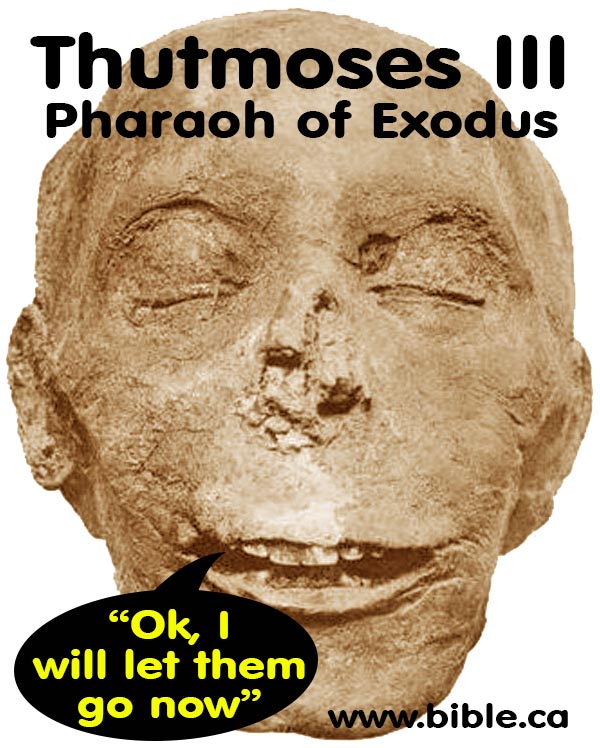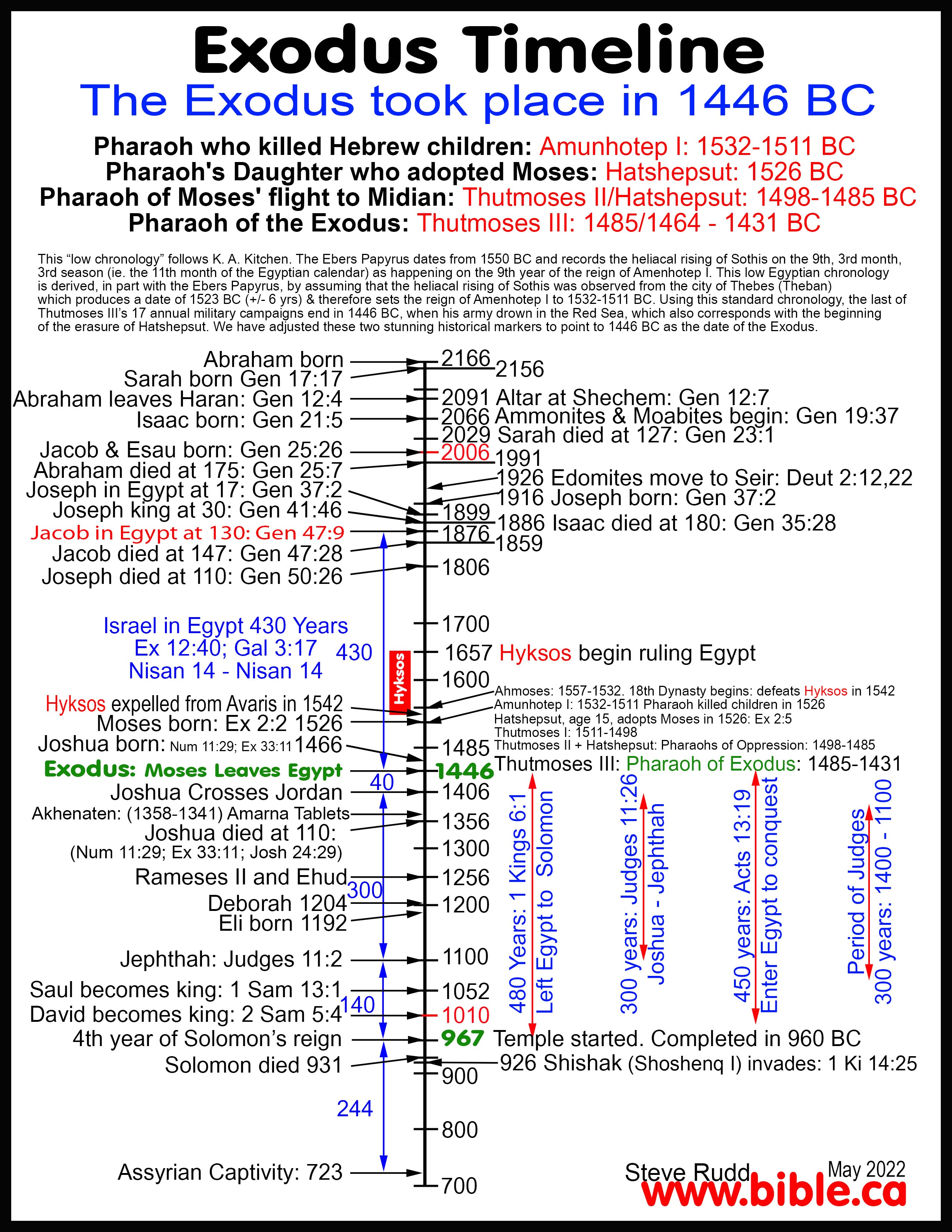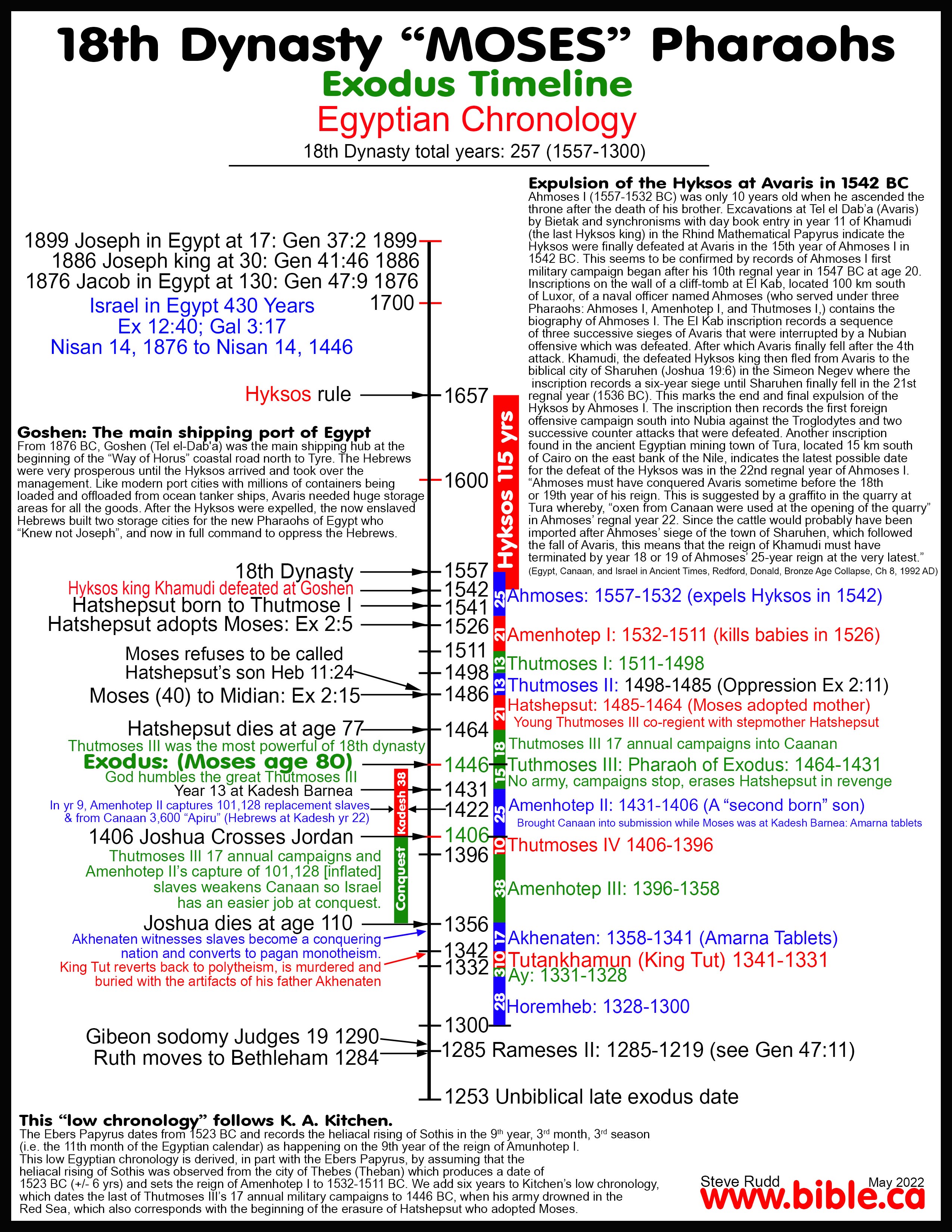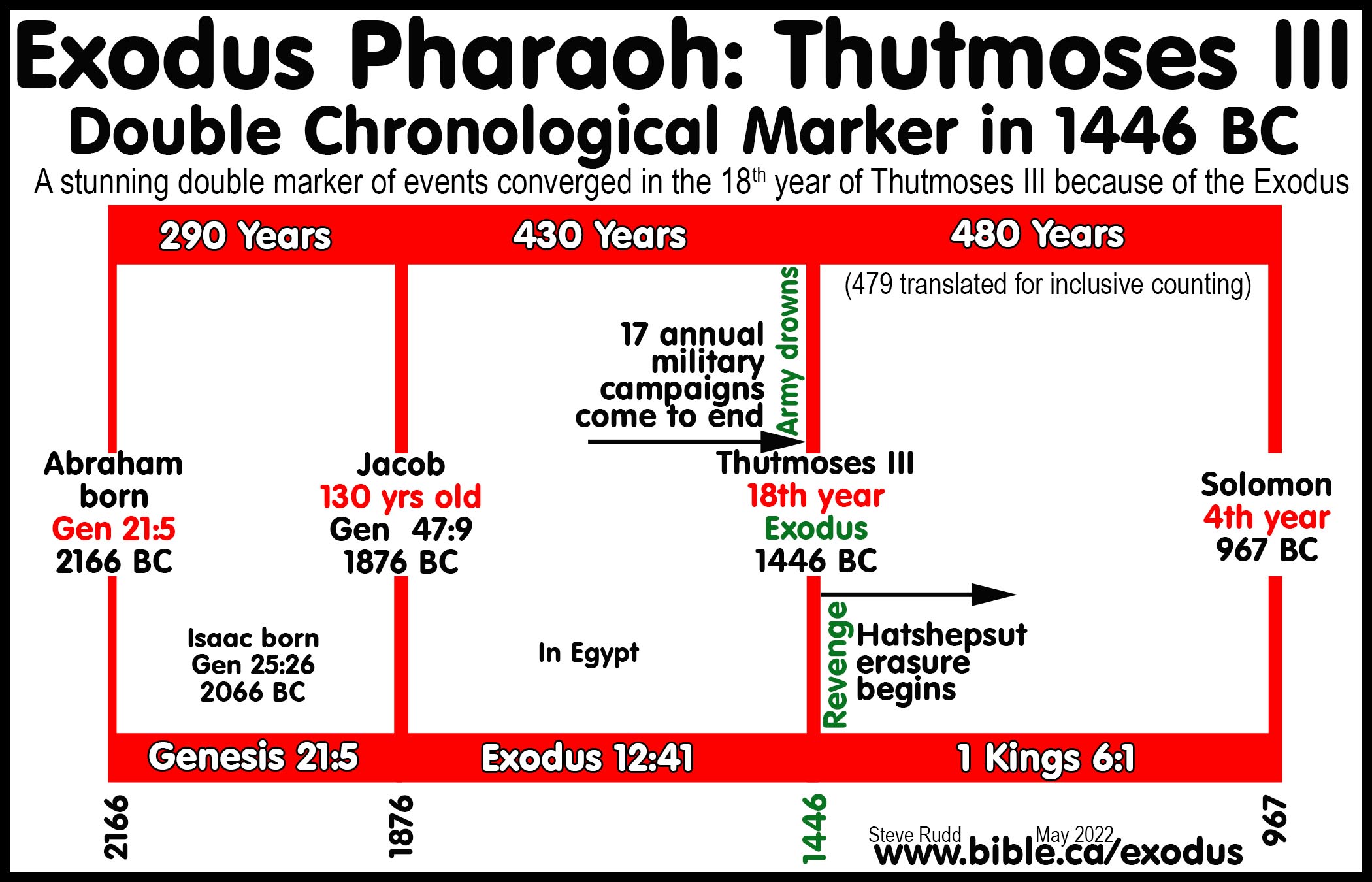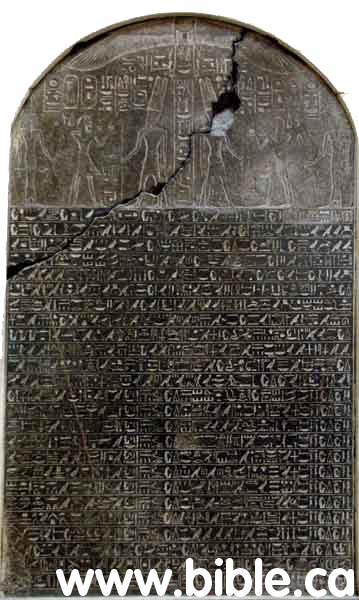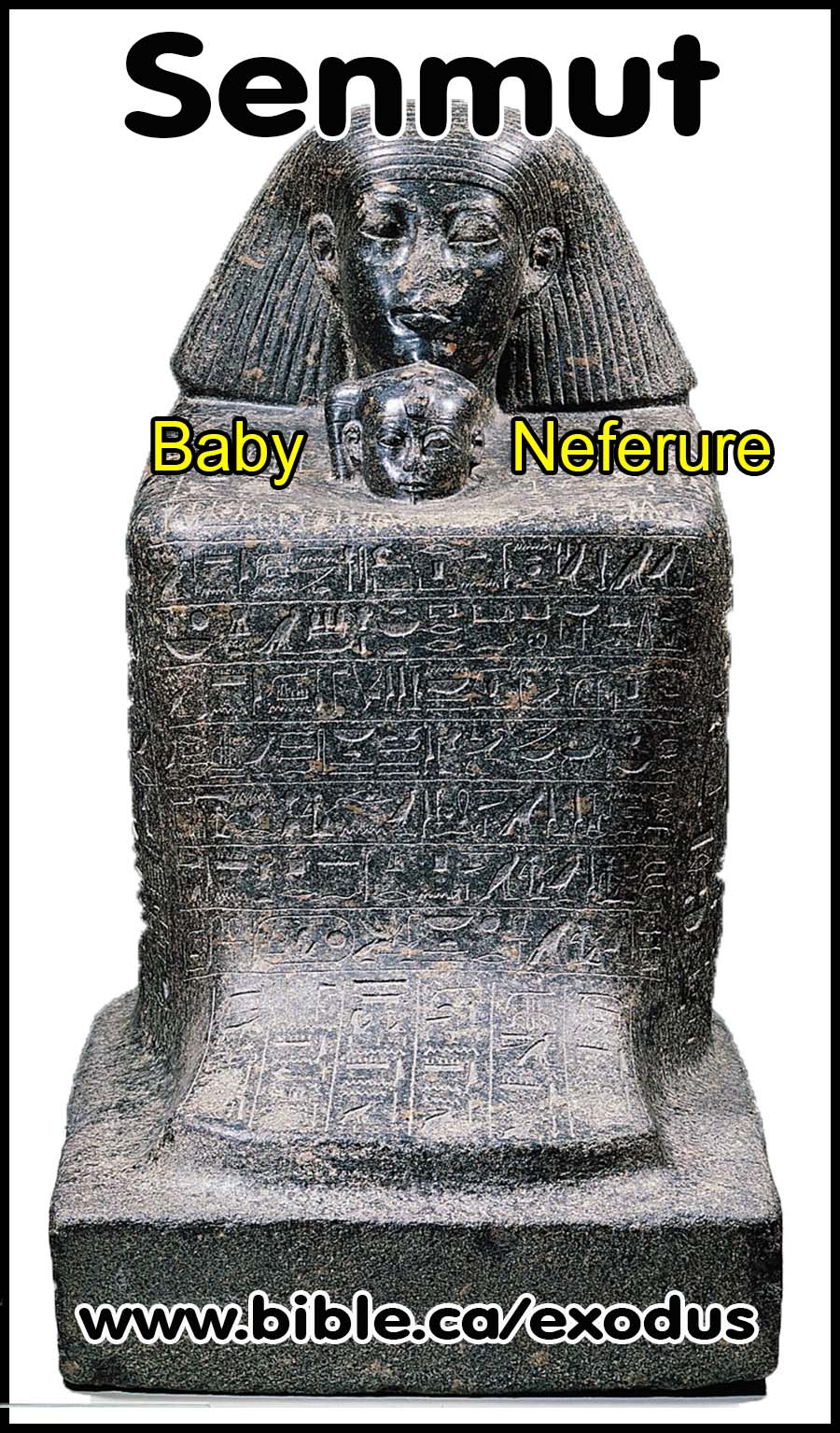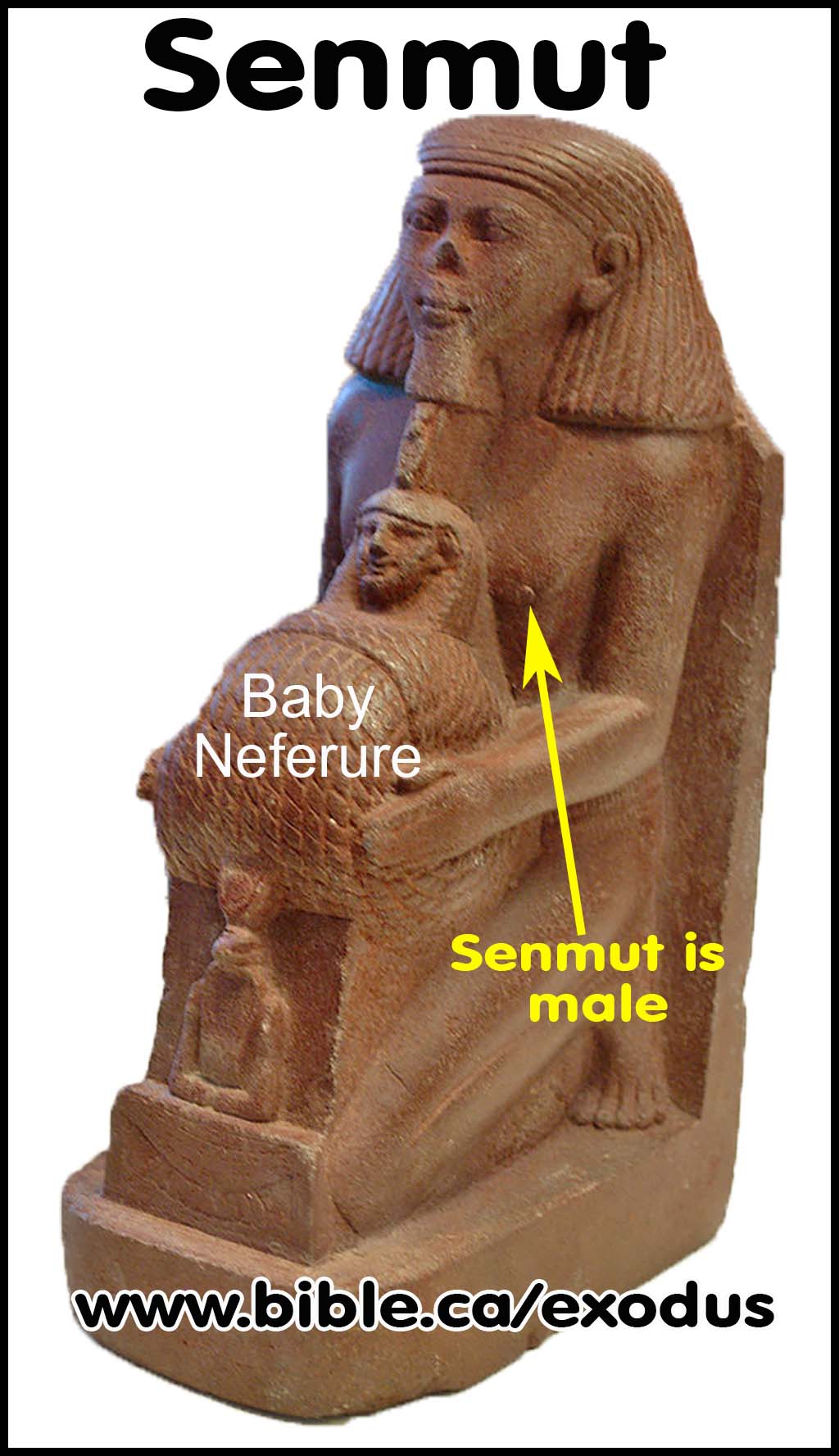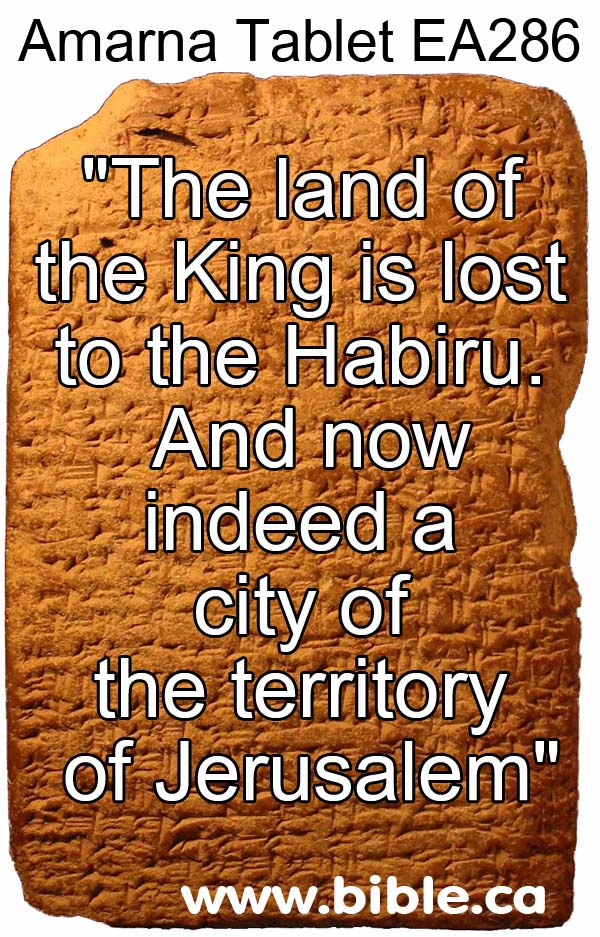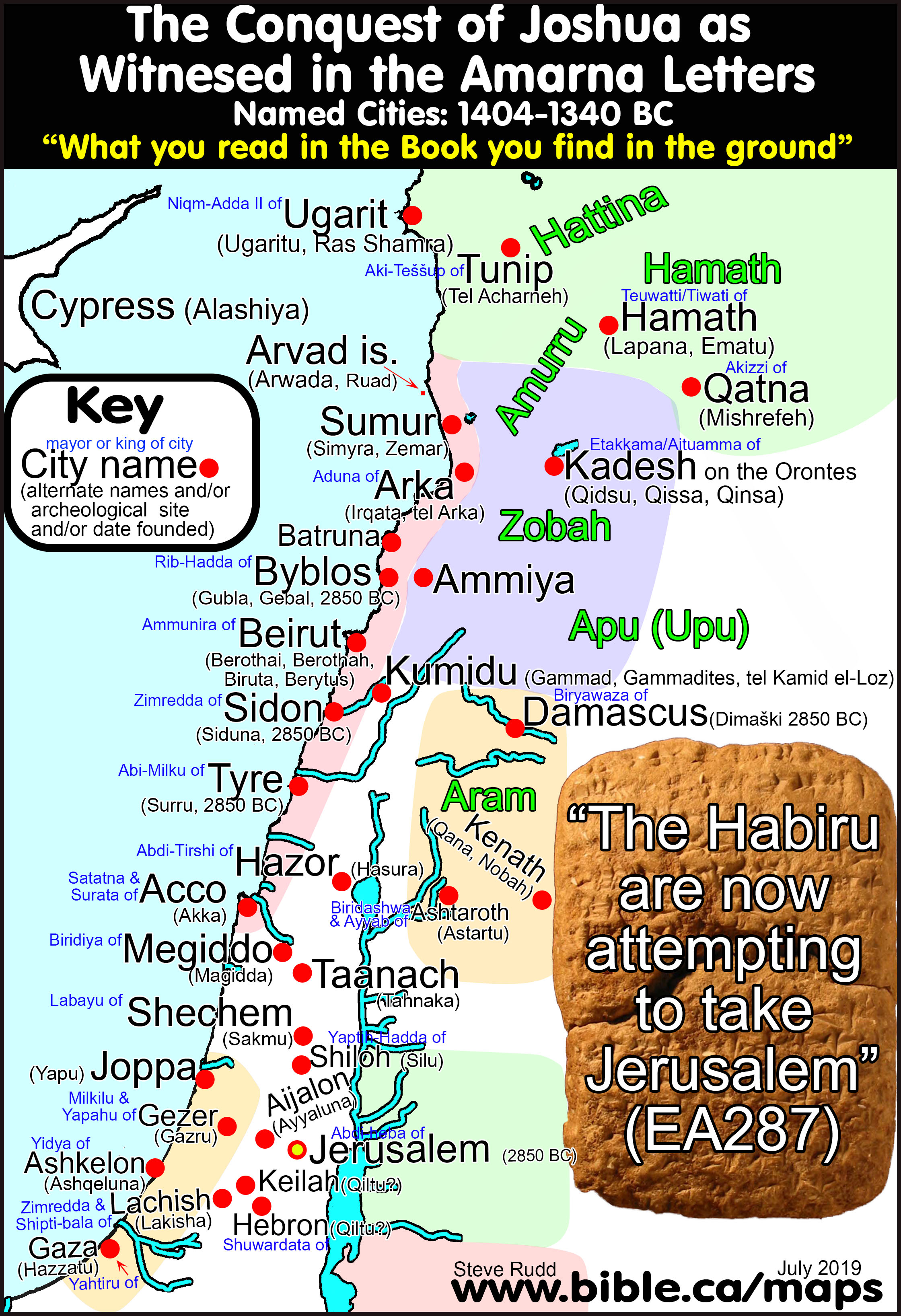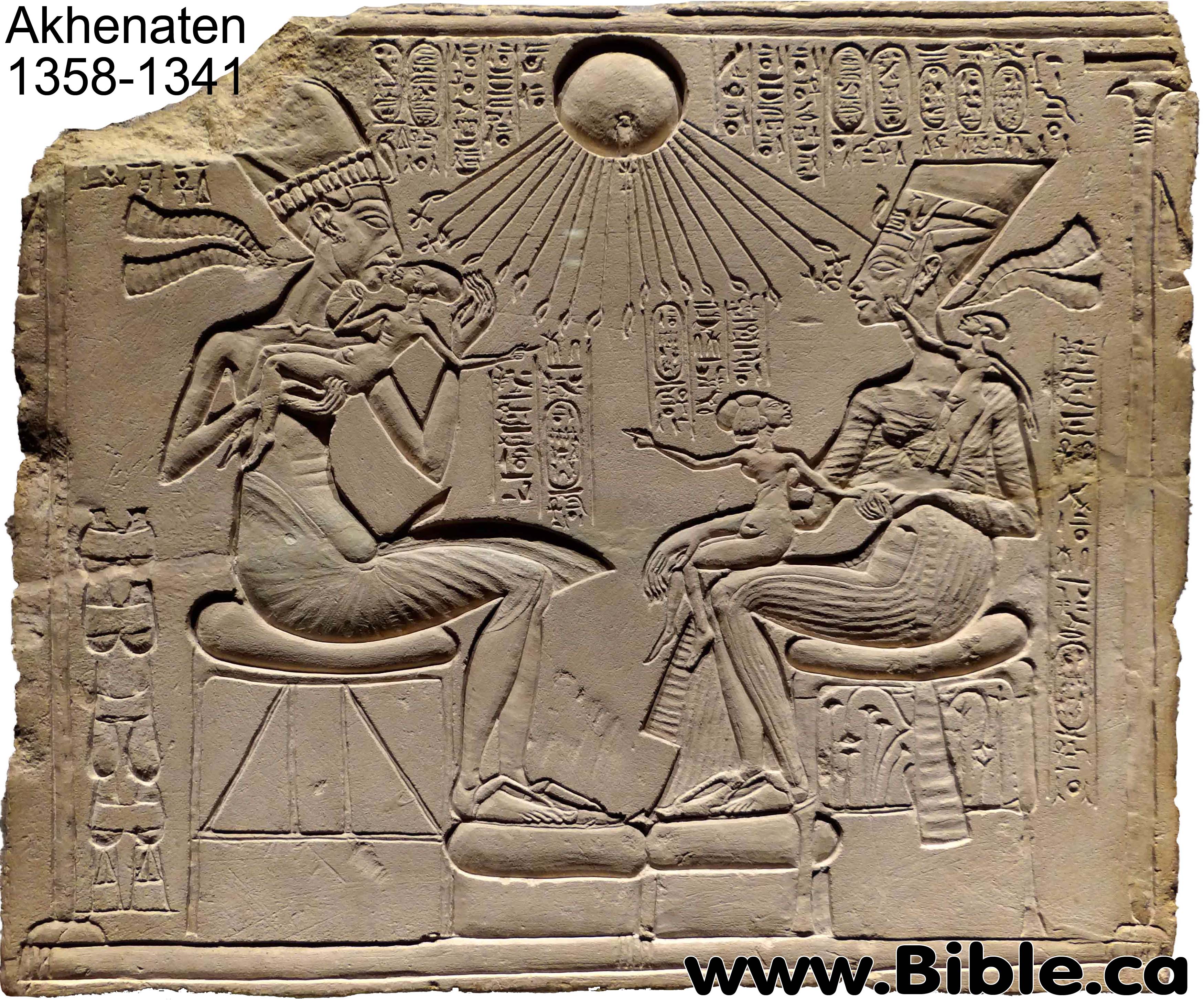Pharaoh of the Exodus: Thutmoses III: (1485-1431)
Thutmoses III was Pharaoh in 1446 BC for a total of 54 years. (1485-1431).
There were three distinct phases to his rule.
1. (1485-1464) First was when he was a baby and his stepmother Hatshepsut ruled as co-regent for 21 years.
2. (1464-1446) Second, after Hatshepsut died, he ruled as Pharaoh for 18 years until the exodus.
3. (1446-1431) Third, he ruled another 15 years after the exodus.
|
The Chronology of the Pharaohs of Egypt This low Egyptian chronology is derived, in part with the Ebers Papyrus, by assuming that the heliacal rising of Sothis was observed from the city of Thebes (Theban) which produces a date for the creation of the Ebers Papyrus of 1523 BC (+/- 6 yrs) and therefore sets the reign of Amenhotep I to 1532-1511 BC. We follow K. A. Kitchen in using the low chronology and add six years to all his dates. |
|||
|
Pharaoh |
Reign |
Dates |
Notes |
|
Ahmose (Nebpehtyre) |
25 |
1557-1532 |
Hyksos defeated, rise of the pharaoh who knew not Joseph. Hatshepsut born 1536 to Thutmoses I |
|
Amunhotep I (Djeserkare) |
21 |
1532-1511 |
Moses born and Hebrew children killed in 1526. Princess Hatshepsut age 10, finds Moses |
|
Thutmoses I (Aakheperkare) |
13 |
1511-1498 |
|
|
Thutmoses II (Aakheperenre) |
13 |
1498-1485 |
Oppression, Moses flees the year before his adopted mother begins to co-reign with Thutmoses III, when Thutmoses II died. Thutmoses III born around 1496 when Moses was 30. Moses 40 in 1486 |
|
Hatshepsut, and her infant stepson Thutmoses III co rule for 20 years |
21 |
1485-1464 |
Hatshepsut died in 1464 at age 77 |
|
Thutmoses III ruler before exodus |
18 |
1464-1446 |
17 annual campaigns came to an end in 1446 never happened because the army drowned in the Red Sea |
|
18th year of Thutmoses III is exactly 480 yrs before Solomon builds temple |
Year |
Exodus |
1 Kings 6:1 |
|
Thutmoses III after exodus |
15 |
1446-1431 |
No campaigns after Exodus |
|
Amenhotep II (Aakheperure) (second born son) |
25 |
1431-1406 |
Weak king who signs peace accords. Israel has been at Kadesh for 12 years when he becomes king and dies the year Joshua crossed the Jordan. |
|
Thutmoses IV (Menkheperure) |
10 |
1406-1396 |
. |
|
Amunhotep III (Nebmaatre) |
38 |
1396-1358 |
. |
|
Akhenaten (Amunhotep IV) |
17 |
1358-1341 |
Become King the year bJoshua dies. Converts to monotheism. |
|
Tutankhamun (Nebkheperure) |
10 |
1341-1331 |
Reverts to polytheism and is murdered. |
|
Ay (Kheperkheperure) |
3 |
1331-1328 |
. |
|
Horemheb (Djeserkheperure) |
28 |
1328-1300 |
. |
|
Totals |
257 |
1557-1300 |
. |
Introduction:
- The date of the exodus was 1446 BC when Israel left Egypt and 1406 BC when they crossed the Jordan into the promised land.
- The Bible is consistent and clear on this date: 1 Kings 6:1; Judges 11:26; Acts 13:19. The three verses are powerful, convincing and consistent.
- When Moses killed the Egyptian, he fled to Midian for 40 years from Thutmoses II who was Pharaoh from 1498-1485 BC.
- Thutmoses III was the Pharaoh of the Exodus who reigned
1485 - 1431 BC in three phases. The exodus occurred in Thutmoses III's 18
year of rule after his mother died.
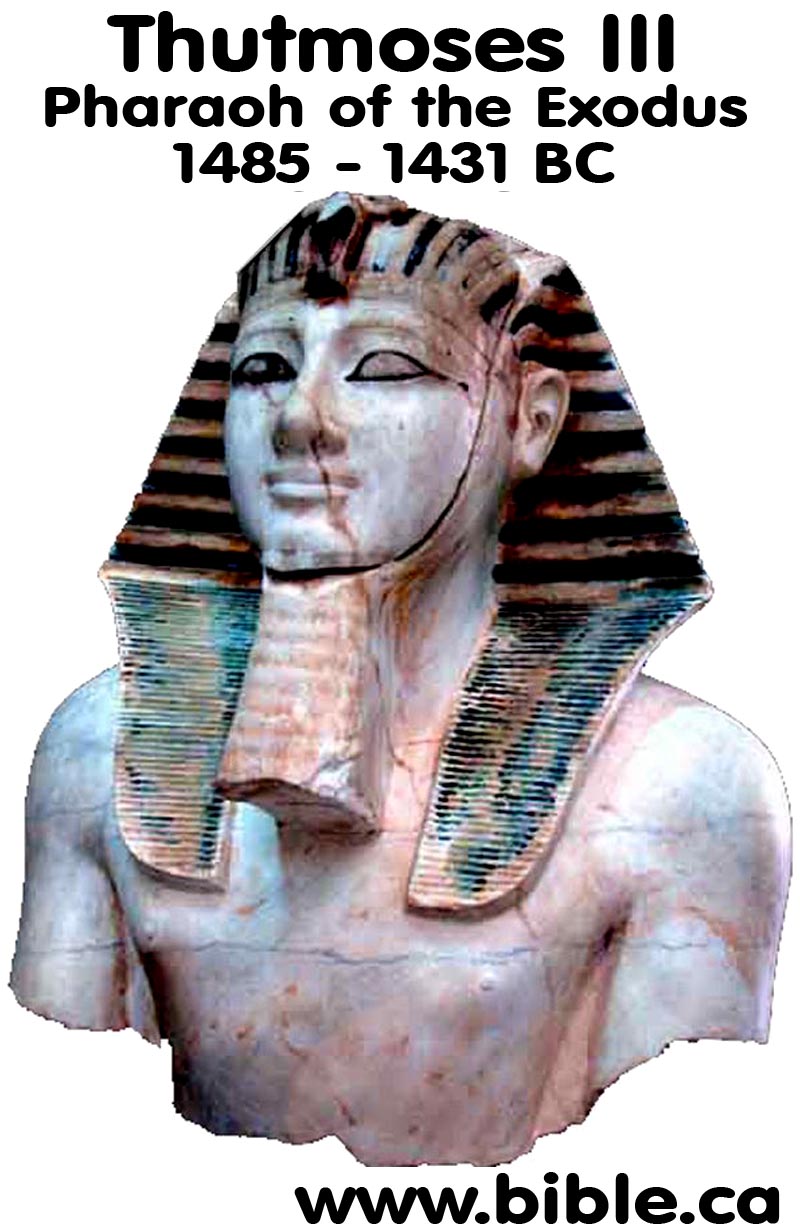
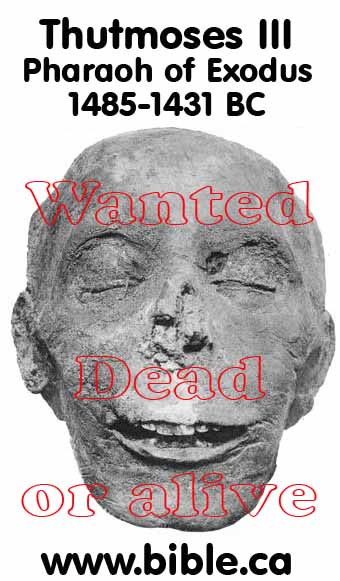
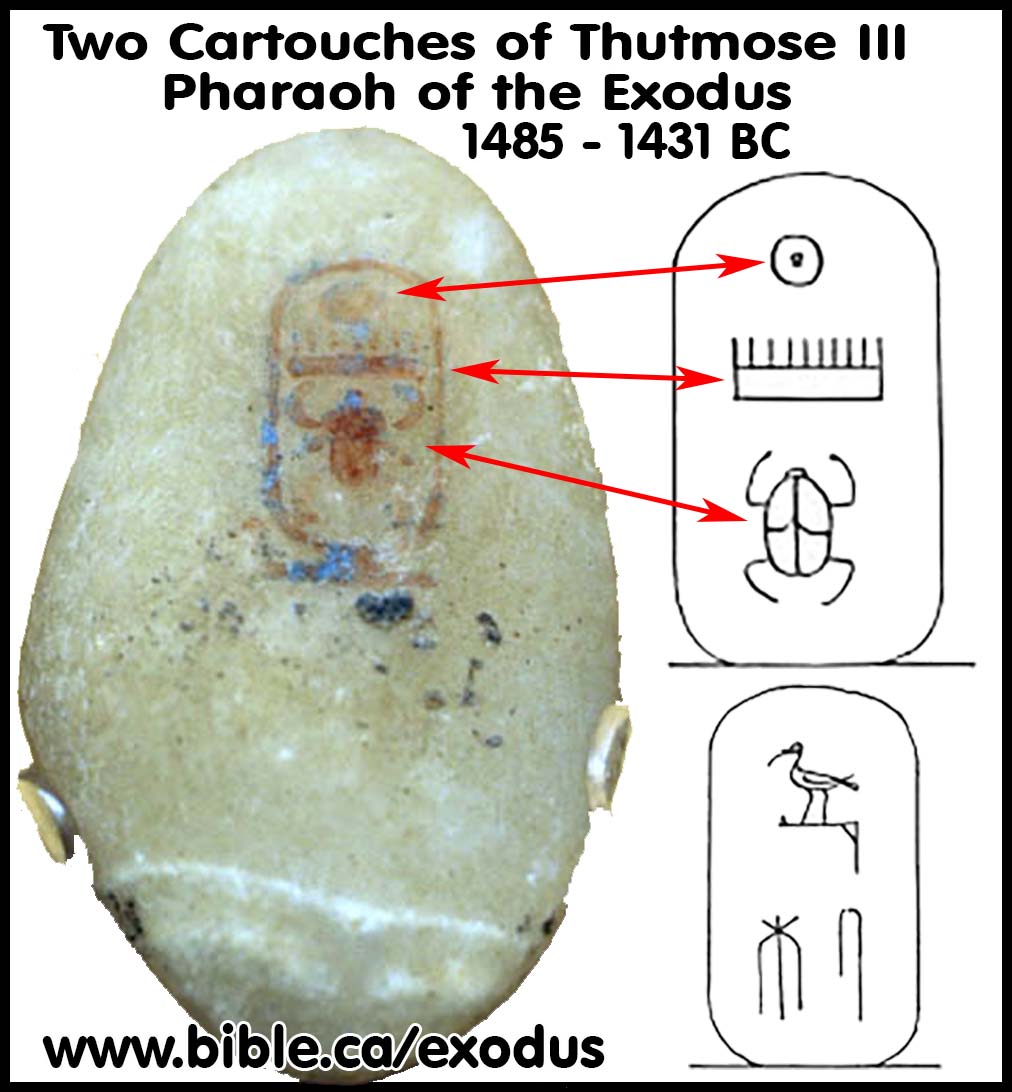
- Late date of 1250 BC where Ramesses II (1279–1213 BC, low chronology) is the pharaoh of the exodus:
- An Exodus in 1250 BC trashes the inspiration of scripture and contradicts known archaeology.
- Advocates of a 1250 BC exodus date quote Exodus 1:11 to prove that Israel lived in the city of “Ramesses” and helped build it. They say, "Obviously the city did not precede the Pharaoh after whom it was named, so Ramesses II must be the Pharaoh of the Exodus. Sounds convincing until you read the passage that says that in 1876 BC Joseph also lived in "the land of Ramesses" (Genesis 47:11). Obviously then Ramesses was named after an ancient city that existed 600 years before he was born.
- The Merneptah
Stele (1205 BC) proves the late exodus date of 1250 BC to be wrong:
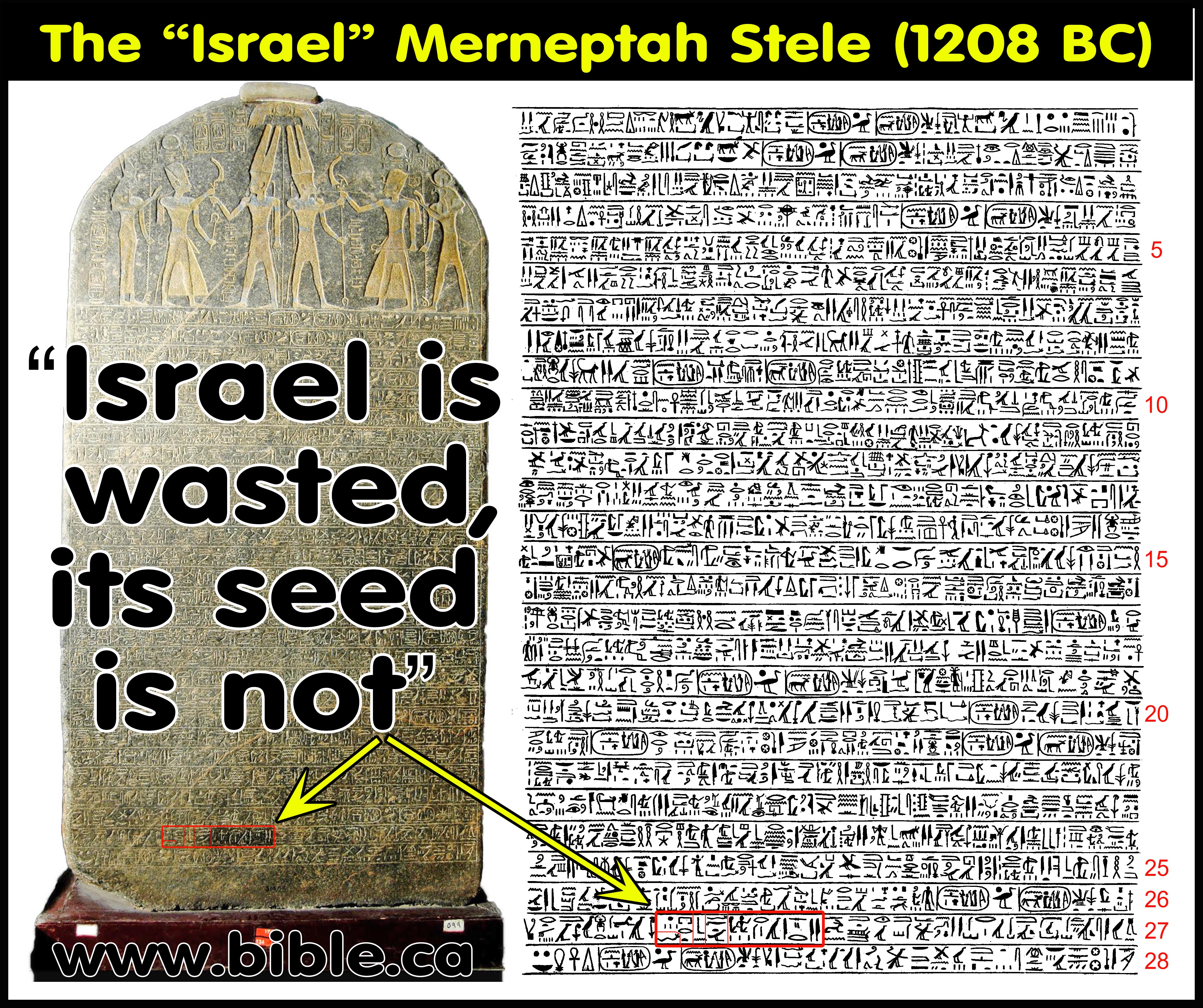
a. Pharaoh Merneptah was the son of the pharaoh Ramesses II (1279–1213 BC, low chronology).
b. Merneptah refutes the late date of 1250 BC for the exodus and Ramesses II as the Pharaoh:
i. If Ramesses II is the pharaoh of the Exodus, then the date of the exodus is 1250 BC.
ii. If the exodus is 1250 BC then the conquest started in 1210 BC and was complete in 1203 BC.
iii. The 1250 BC exodus date is impossible because in 1205 BC, Merneptah boasts that he conquered Israel in the middle of the conquest of Joshua.
c. Since the exodus was really in 1446 BC, then the Merneptah Stele was created during the time of Deborah (Judges 4, 1204-1144 BC).
d. Merneptah’s invasion in 1205 BC is a perfect synchronism for the chronology of the judges:
i. Ehud judged Israel for 98 years between 1302-1204 BC. There was an initial 18 years of oppression under the Moabites (Judges 3:14) between 1304-1286 BC. Then in 1284 BC Ehud killed Ehud and Israel experienced 80 years of peace ending in 1204 BC.
ii. From 1204-1184 BC, there were 20 years of oppression until Deborah kills Sisera, defeats Jabin and burns Hazor in 1184 BC. It has been known for some time that archeologists have misdated the second burning of Hazor by Deborah too early at 1230 BC because they fail to mark the death of Joshua in 1356 BC who burned Hazor the first time in 1401 BC. Joshua was Moses’ “youth servant” (Ex 33:11; Num 11:28) who was born in 1466 BC, was 20 years old at Mt. Sinai in 1446 BC, lived 110 years then died in 1356 BC.
iii. The beginning of the period of Israel’s oppression in 1204 BC one year later than when Merneptah attacked Israel in 1205 BC.
iv. Therefore, when we lay the archaeology of Merneptah Stele over top of the accepted chronology of the Judges, it is a perfect fit!
v. What you read in the book you find in the ground!
- Archaeologists Kathleen Kenyon and Israel Finkelstein are enemies of the Bible:
- As a professional archaeologist, I can testify that the vast majority of my fellow archaeologist who conduct excavations in Israel do not believe the Bible is an historical document. The vast majority of Israeli archaeologists living in Israel today believe their own history in the Tanakh is fiction.
- Bible hating archaeologists like Kathleen Kenyon who excavated Jericho and Israel Finkelstein who excavated Shiloh, have deceived the world by concluding the exodus is a myth.
c. John
Garstang excavated Jericho 1930-1936 and concluded Jericho was destroyed in
1406 BC by Joshua confirming the Bible. Garstang documented imitation Cypriot ware pottery from the late 15th century BC he found at
Jericho. Kathleen Kenyon excavated Jericho 1952-1958 and concluded that
the Bible story of Jericho was a myth because the walls of Jericho had already
fallen 150 years before Joshua arrived in 1406 BC. Her conclusion was based
upon the lack of Cypriot ware pottery used in the 15th
century BC, although Garstang had documented local Canaanite imitation
Cypriot pottery 20 years earlier. Dr. Bryant Wood who has a PhD in Late Bronze
Canaanite pottery reexamined her pottery finds and proved she had misdated the
LB I destruction layer of the city. Not only did the Canaanite pottery date to
LB I, Wood documented imitation Cypriot ware that Kenyon had ignored. Kenyon never did an in-depth analysis of the pottery from the
destruction layer and totally ignored the local Canaanite 15th
century BC pottery which Garstang had correctly dated. Wood confirmed
the work of Garstang and refuted Kenyon’s conclusion that the Bible story was a
myth.
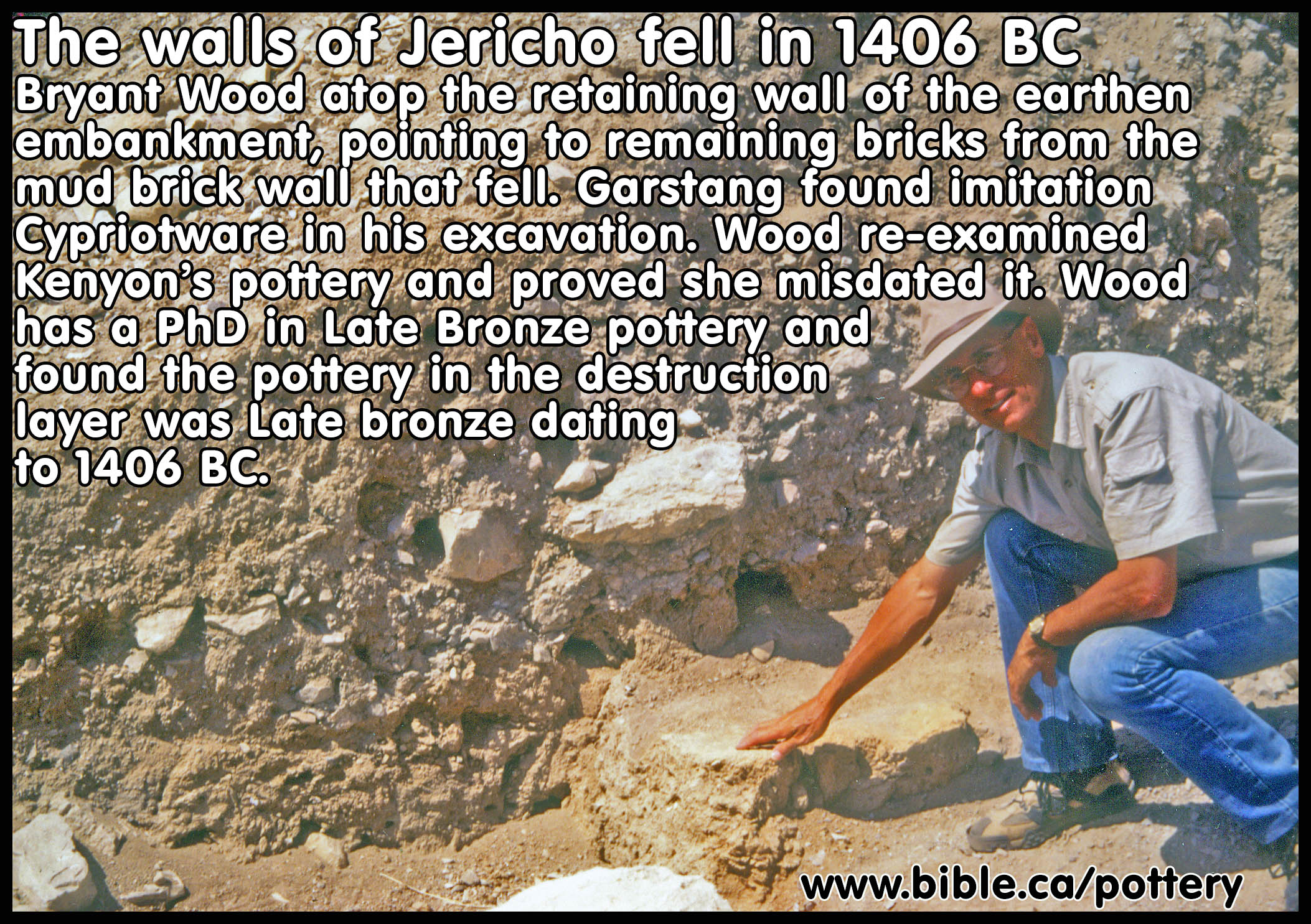
- Israel Finkelstein is a minimalist, meaning he believes Abraham, the exodus, David and Solomon are all mythical figures invented by Jews in the 7th century BC to create a cultural backdrop. Finkelstein concluded in his excavation 1993 report at Shiloh that the site was unoccupied 1400-1100 BC, the precise period when the Bible says the tabernacle tent was active. However, the author is staff archaeologist of the current excavations at Shiloh 2017-present and clear evidence of occupation between 1400-1100 BC has been discovered.
- The problem in both these cases is that Bible commentaries, dictionaries and encyclopedias quote Kenyon and Finkelstein, despite the fact their conclusions have been refuted. This is like how university biology textbooks in 2020 are filled with evidences of evolution that have been debunked for over 100 years.
- Summary of dates revealed in the Bible:
- The time after leaving Egypt to 4th year of Solomon's reign is 480 years: 1 Kings 6:1 (Solomon reigned in 970 BC when David died.)
- The time from crossing the Jordan to Jephthah is 300 years Judges 11:26 (Jephthah lived in 1100 BC)
- The time from entering Egypt until the time of Samuel was 450 years: Acts 13:19 (400 + 40 + 10: Joshua took 10 years to take the land)
- The period of the Judges is 262 years. (From death of Joshua in 1356 BC to birth of Samuel in 1094 BC)
- The many genealogies of the Bible verify and confirm everything.
- Trust the Bible when it dates the exodus to 1446 BC. Reject 1250 BC for the date of the exodus.
A. Scripture dates the exodus to 1446 BC: 1 Kings 6:1, Judges 11:26-28 and Acts 13:19-20
1. The Bible says Israel spent 430 years in Egypt: 1876-1446 BC
a. There are three verses that give the duration of the time spent in Egypt. Exodus 12:40-41 and Galatians 3:17 both say 430 years whereas Genesis 15:13 says 400 years. The difference is easy to understand because God was speaking to Abraham in general times looking forward and the other two were quite specific times looking back.
i. "Now the time that the sons of Israel lived in Egypt was four hundred and thirty years. And at the end of four hundred and thirty years, to the very day, all the hosts of the Lord went out from the land of Egypt." Exodus 12:40-41
ii. "What I am saying is this: the Law, which came four hundred and thirty years later, does not invalidate a covenant previously ratified by God, so as to nullify the promise." Galatians 3:17
iii. "God said to Abram, "Know for certain that your descendants will be strangers in a land that is not theirs, where they will be enslaved and oppressed four hundred years." Genesis 15:13
b. Apostle Paul said that from the time Israel entered Egypt till they fully settled Canaan under Joshua was 450 years. This is calculated by adding the generalized 400 years Abraham was told in Genesis 15:13 plus 40 years in the wilderness plus 10 years it took Joshua to fully occupy the land. It is important to notice that Paul is approximating because he said "About 450 years". God in general terms told Abraham 400 years in Genesis 15:13, but Paul knew that the specific time was 430 years in Exodus 12:40-41; Galatians 3:17. "When He had destroyed seven nations in the land of Canaan, He distributed their land as an inheritance-all of which took about four hundred and fifty years." Acts 13:19
- Connecting Solomon’s temple to the exodus in 1446 BC:
- Solomon began building the temple in Jerusalem in the 4th year of his reign. This verse says that 480 years before the 4th year of Solomon's reign Israel left Egypt.
- That makes the exodus 1446 BC: "Now it came about in the 480th year after the sons of Israel came out of the land of Egypt, in the fourth year of Solomon's reign over Israel, in the month of Ziv which is the second month, that he began to build the house of the Lord." (1 Kings 6:1)
- Those who try to symbolize the 480 years into 12 generations of 40 years are gravely mistaken. Why would such a symbolic number be applied to the specific of "the 4th year of Solomon". Further, the foundation of the temple is a critical date of great importance. The idea that the number 480 is symbolic and not literal is not reasonable. If God intended there to be any symbolism in the literal 480 years being 12 generations of 40 years (and there may not be), this shows the power of providence of God to bring such things about.
- There are other examples of these precise dating in scripture at key and important times. "And at the end of four hundred and thirty years, to the very day, all the hosts of the Lord went out from the land of Egypt." (Exodus 12:41) It makes perfect sense that just as the 430 years TO THE VERY DAY, was literal, so too is the date of the temple started 480 years EXACTLY. There is no valid reason why the number should not be taken literally and many reasons why it should be taken literally.
- Jephthah’s 300 years:
- Jephthah who lived in 1100 BC said Israel crossed the Jordan 300 years earlier.
- Sihon, the Ammonite king, wanted his land back that Israel took under Joshua. Jephthah asks Sihon why he suddenly wants the land back 300 years later and never requested such before now. "'While Israel lived in Heshbon and its villages, and in Aroer and its villages, and in all the cities that are on the banks of the Arnon, three hundred years, why did you not recover them within that time? 'I therefore have not sinned against you, but you are doing me wrong by making war against me; may the Lord, the Judge, judge today between the sons of Israel and the sons of Ammon.' " But the king of the sons of Ammon disregarded the message which Jephthah sent him." (Judges 11:26-28)
- Low chronology takes the block of 258 years that is the sum of the length of time each Pharaoh was king and defines it as a single unit. (25, 21, 13, 13, 21, 18, 15, 26, 10, 38, 17, 10, 3, 28).
- We are uncertain exactly when they were king, but we know how long and in what order!
- Archeology doesn't tell us the date they lived, but it certainly tells us how long each ruled!
- The problem is accounting for unknown coregencies which would collapse the time scale. We solved the problem, by ignoring that which is uncertain (when they ruled) and focused on what was very certain: how long each ruled, and in what order.
- Without archeology, we would be unable to know any of this, but we have found actual tombs, inscriptions, mummies, war records that supply the information we need with great certainty.
- Our approach, therefore, began with the assumption that the exodus happened in the 18th dynasty of Egyptian Pharaoh's.
- Because historians are "all over the map" in the dates they lived to over 75 years, we considered all possible candidates for the pharaoh of the Exodus. After a careful and detailed study of all the 18th dynasty pharaoh's, it became rapidly clear Thutmoses III was the only real possible candidate as the Pharaoh of the Exodus.
- Thutmoses III was he pharaoh in 1446 BC using low Chronology
- Two historical synchronisms occurred in 1446 BC. His 17 annual military campaigns ended in his 18th year of sole reign after his mother Hatshepsut died. Her image was chipped out of Egyptian relief starting in 1446 BC because she adopted Moses who brought about the destruction of Egypt through the 10 plagues.
- He was the most powerful of the 18th dynasty kings and a perfect candidate for God to humble.
- Think of our solution as two fixed blocks of time that are "Indivisible Units of Chronology": Block one is the fixed 480 years between the Exodus and the 4th year of Solomon in 1 Kings 6:1. Block two is the fixed 258-year block of time for the 18th dynasty Pharaoh's. We know that the Exodus of 1446 occurs in the middle of the 18th dynasty so the only problem is exactly where we lock the two blocks together. Our solution was that 1446 BC is the 18th year of Thutmoses III. We used a similar approach to solve Eli - Solomon Chronology.
- Using the Judges to calculate the exodus at 1446 BC:
- The chronology of the Judges fits almost perfectly from Othneil, the first Judge, down to Jephthah in 1100 BC.
- The chronology of the Judges from Jephthah down to Solomon also fits almost perfectly within 6 years.
- In proving the exodus of 1446 BC, we can use the Jephthah to Solomon Chronology in this way: According to Judges 11:26-28, Jephthah lived 300 years after Israel crossed the Jordan which is 1100 BC. Solomon's 4th year as king was 480 years after Israel left Egypt and 140 years after Jephthah. The period of the Judges ended when David became king in 1010 BC, since Samuel judged till he died in 1014 BC. If we take the raw chronological numbers from the book of Judges we get this: Jephthah 6 years + Ibzan 7 years + Elon 10 years + Abdon 7 years + Eli 40 years + Samuel 60 years (who died in 1014 BC) + 40 years of David + 4 years of Solomon = 174 years. Unadjusted it is only 34 years too long. (Remember the Bible tells us plainly that Samson judged at the same time as Jephthah, so we don't count Samson or the oppression that preceded him.) But we also know that Eli judged from 1134 - 1094 BC which was before Jephthah! So we can actually ignore the 40 years Eli judged altogether! Now if we add Jephthah's 300 years back to the crossing of the Jordan and add 40 years in the wilderness and add the 134 years forward from Jephthah to the 4th year of Solomon, we get 474 years. 1 Kings 6:1 says the actual period was 480 years. Using the Judges Chronology, the difference is only 6 years! This is a stunning confirmation of the statement in 1 Kings 6:1 that the exodus happened 480 years before the 4th year of Solomon. It clearly refutes the 1250 BC exodus.
- All this makes it utterly impossible for the Bible believer to teach the exodus took place in 1250 BC. Trust your Bible, not Bible trashing archeologists who teach a 1250 BC exodus.
- Detailed
study on the Chronology of Judges
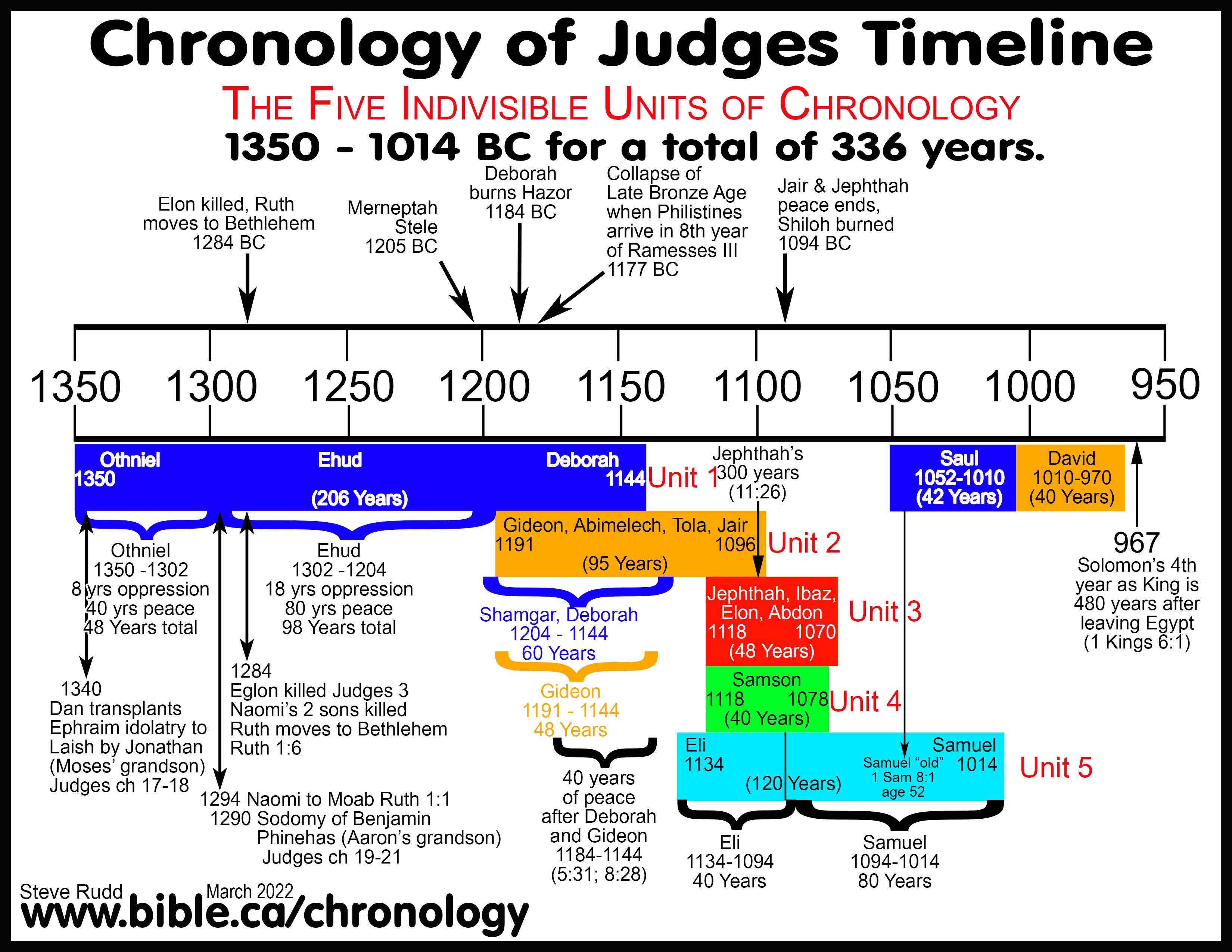
- Bible chronologies and genealogies says the Exodus happened in 1446 BC:
- To suggest that the exodus happened in 1250 BC creates problems with the many chronologies and genealogies within the Bible that take us from Adam to Christ.
- The ten generations between Adam and Noah: Gen 5. "Noah was five hundred years old, and Noah became the father of Shem, Ham, and Japheth." Genesis 5:32
- The ten generations between Noah and Abraham: Gen 11
- The twelve tribes from Jacob to David: 1 Chron chapters 2 - 9
- Adam to Jesus: Luke 3:23-38; Matt. 1:1-17
- 1 Kings 6:1, Judges 11:26 and Acts 13:19 are powerful, convincing and consistent.
- They are powerful because there is a witness of three distinct and explicit texts that give a date of 1446 BC for the Exodus.
- They are convincing because they are stated clearly in non-figurative narratives cradled in true historical stories.
- They are consistent because the three texts all give the same date, not different dates.
B. Egyptian Chronology: Six-year shift applied to Kitchen’s Low Chronology
- We accept and follow the low chronology of Kenneth Kitchen, which makes Thutmoses III the pharaoh of the exodus, then make an adjustment sliding his entire time scale six years earlier.
- Kitchen’s date for the 18th regnal year Thutmoses III’s sole reign after his mother died is 1440 BC.
- Our chronology slides the 18th year of Thutmoses III six year older from 1440 BC to 1446 BC.
- Professional Egyptologists all agree that a 6-year shift is well inside the error margin of any Egyptian chronology and therefore possibly correct.
- The year of the exodus in 1446 BC had two Egyptian chronological markers:
- Thutmoses III’s 17 annual campaigns of war into foreign lands came to an end in 1446 BC because his entire army was drowned in the Red Sea.
- The erasure of images of Hatshepsut began in 1446 BC because she adopted Moses who destroyed Egypt through the ten plagues.
- The pharaoh of the Exodus is dependent upon which of low or high Egyptian chronology is correct. It all depends upon which city the “heliacal rising” of the Dog Star was observed.
- Thutmoses III, low chronology: If “heliacal rising” of the Dog Star was observed from Thebes, then low chronology is correct and Thutmoses III would be the pharaoh of the Exodus because his reign falls between 1450 – 1440 BC.
- Amenhotep II, high chronology: If “heliacal rising” of the Dog Star was observed from Memphis, then low chronology is correct and Amenhotep II would be the pharaoh of the Exodus because his reign falls between 1450 – 1440 BC.
- Our low Chronology is remarkably orthodox, but there is one difference.
- We can precisely pinpoint the Exodus of 1446 with the 18th year of Pharaoh Thutmoses III. Just as all old Testament Bible events can be dated in relation to the reign of Solomon, so too all the Pharaoh's of Egypt can be dated in relation to the 18th year of Thutmoses III. Both are anchors in historical dating.
- This represents original research and we are not aware of anyone who has ever connected the 18th year of Thutmoses III's reign with the year of the Exodus in 1446 BC.
- We use the Low Egyptian chronology as proposed by A. K. Kitchen and add 6 years:
- The Ebers Papyrus dates records the heliacal rising of Sothis on the 9th year, 3rd month, 3rd season (i.e. the 11th month of the Egyptian calendar) as happening on the 9th year of the reign of Amenhotep I.
- Egyptian Low Chronology + 6 years: We adjusted Kitchen's low chronology dates upward by 6 years. The low Egyptian chronology is derived, in part in part with the Ebers Papyrus, by assuming that the heliacal rising of Sothis was observed from the city of Thebes (Theban) which produces a date of 1523 BC (+ or - 6 years, so we use 1529 BC) and therefore sets the reign of Amenhotep I to 1532-1511 BC.
- High Chronology: The high Egyptian chronology is derived, in part with the Ebers Papyrus, by assuming that the heliacal rising of Sothis was observed from the city of Memphis (Memphite/Heliopolitan) which produces a date of 1541 BC and therefore sets the reign of Amenhotep I to 1550-1529 BC.
- Egyptian chronology is a mess and must be grounded upon Biblical dating: The Bible is the far more reliable dating system for historical chronology and synchronisms. There are many reasons why we cannot rely upon the chronologies of the 18th dynasty pharaohs as being reliable given the almost certain fact that there are many unknown coregencies which would collapse the chronology by at least 6 years. So we are confident in our choice to use Kitchen's low chronology numbers and then simply adding 6 years to each.
- Kenneth Kitchen discusses Egyptian Chronology in the Anchor Bible Dictionary:
- "The rise of the Nile was not the only event noticed in the July time of the year in Egypt. Quite by coincidence, the so-called “heliacal rising” of the Dog Star (Gk Sothis, from Egyptian Sopdet) also took place on the original July “New Year” of the civil calendar. (The heliacal rising of Sothis is defined as that day on which this star first becomes visible just before sunrise, after 70 days of invisibility, Parker 1950: 7.) Because of the behavior of Egypt’s too-short civil calendar, some 1460 years have to elapse between one sighting of this heliacal rising of Sothis on the 1st day of the 1st month of the 1st season (New Year’s Day) in the civil calendar and the next time this exact sighting could reoccur. This period of about 1460 years is therefore called a Sothic cycle. Fortunately, one such date point is known: within the period 139–42 a.d. (Parker 1976: 182). Therefore, allowing for variations in the stellar motion of Sothis, it can be calculated that previous Sothic cycles would begin in 1313 b.c. and 2769 b.c., if observed at Memphis (see Parker 1976: 182, who uses astronomic notation). Fixing the date of these cycles should (in theory) help us to date any reign of a pharaoh, if a heliacal rising of Sothis is found mentioned in a particular year of his rule on a specific date in the civil calendar—one only needs to know inside which cycle his reign falls. For example, if some king who belonged within the period 2700 to 1350 b.c. had a document dated to his Year 1, mentioning the rising of Sothis on the 6th day of the 4th month of the summer season (11th month in the year), it is clear that the civil calendar had crept forward 335 days since such a rising last happened on its New Year’s Day. So, 4 × 335 years had elapsed since 2769 b.c., putting our theoretical king’s accession (Year 1) at about 2769 minus (4 × 335) years b.c., or 2769 minus 1340 = 1429 b.c. Alas, in practice things are not so simple. There are several complications. First, one must allow for a 4-year margin of error (before quarter days add up to one day, among other factors). Second, the geographical location of any reported Sothic sighting affects reckoning of the date. In practice, the further south the sighting, the later the date b.c. So, we need to know, for example, whether a report of Sothis was made in Memphis, Thebes, or Elephantine. Only two usable Sothic rising reports are known to us at present: one in Year 7 of Sesostris (Senwosret) II or III, and one in Year 9 of Amenhotep I. The former one may have been observed either in Memphis or Elephantine; there would be a roughly 30-year difference in date, depending on place of observation. The latter one would have been seen in either Thebes (source of the Ebers Papyrus bearing the datum) or Elephantine; the date difference is then only about 11 years. (For the suggestion of Elephantine as the point of observation for both risings, leading to ultra-low dates for both, see Krauss 1985; contrast Kitchen 1987a: 42–44, 47, where the corresponding options of observations made at Memphis and Thebes respectively are preferred.)" (ABD, Egypt, History of, Chronology, K. A. Kitchen, v2, p324)
- "A rising of Sothis is recorded for Year 9 of Amenhotep I in Papyrus Ebers, a document found at Thebes. If the observation of Sothis was also made at Thebes, the most natural solution, then it would lead us to set the accession of Amenhotep I at 1525 b.c., and the beginning of the 18th Dyn. (and NK) with the accession of Ahmose I at ca. 1550 b.c. If, however, we follow the theory of Krauss that all Sothis observations were taken far south in Elephantine, then the 18th Dyn. would have begun 11 years later, in 1539 b.c. From the reign of Thutmose III we have a lunar date which would imply his accession to the throne in 1479 b.c., in line with a similar datum from the reign of Rameses II, favoring his accession in 1279 b.c., in conjunction (1) with synchronisms with other Near Eastern rulers and (2) with the lapse of generations linking the Rameside period to later epochs. If the 18th Dyn. began in 1550 b.c., there is ample time for the reigns of Thutmose I and II in between those of Amenhotep I and Thutmose III. If, however, the dynasty began in 1539 b.c. (so Krauss 1985), then only 13 years are available for those two reigns—which is decidedly cramped and not realistic. Between the reigns of Thutmose III of 54 years (1479–1425 b.c. and Rameses II of 66 years (1279–1213 b.c.), all the intervening reigns can be fitted in without any serious problems. Most lengths of reigns can be determined quite closely (Kitchen 1987a; 1989). Bones of contention include the possibility of a coregency between Amenhotep III and Akhenaten, which would require a longer reign for Amenhotep II; and whether or not Amenmesses of the 19th Dyn. had an independent reign (on the latter point, see Kitchen 1987b)." (ABD, Egypt, History of, Chronology, K. A. Kitchen, v2, p327)
- Our Egyptian Chronology chose Thutmoses III as the Pharaoh of the Exodus because an incredible double marker stands out two flashing neon lights in Thutmoses III's life. Two key events happened as a direct result of the 10 plagues and the exodus of Moses in 1446 BC:
- First: After 17 yearly military campaigns, they suddenly stopped because pharaoh’s army was killed in the Red Sea.
- Second: The beginning of the erasing of Hatshepsut’s image from statues and records at precisely the same time because she adopted Moses.
- Thutmoses III’s annual campaigns ended out of necessity and the erasure of Hatshepsut’s image began out of revenge.
- 1 Kings 6:1 confirms the 18th dynasty pharaohs witnessed the Exodus:
- Using 1 Kings 6:1 we can harmonized the 18th dynasty Pharaohs directly with the reign of Solomon.
- The Exodus occurred exactly 480 years (479 literal BC years when adjusted for inclusive counting) before the temple was built by Solomon.
- Looking at the many candidates for Pharaoh in 1446, we were able to conclude, with a high level of confidence, that the 18th year of Thutmoses III's reign after his stepmother Hatshepsut died, is the date of the exodus in 1446 BC. It is a truly stunning fit!
- This Chronology creates a solid anchor between the 18th year of Thutmoses III as being the date of the Exodus and the 480 years to the time Solomon started the temple. (1 Kings 6:1).
- Connecting the 18th year of Thutmoses III with the year of the exodus has never been done before.
C. Thutmoses II and Hatshepsut: Pharaoh’s of the oppression:
- The Hyksos “knew Joseph” but the 18th dynasty "did not know Joseph":
- The slavery of the Hebrews coincides with the Hyksos being expelled from Egypt. The Hyksos rule Egypt for 119 years (1657-1538 BC): “The Pharaohs who knew Joseph”. The timing of the expulsion of the Hyksos and the enslaving of Israel perfectly fits Thutmoses III as the pharaoh of.
- In 1657 BC the Hyksos overthrew the pharaohs of Egypt and built their palaces at Tel el-Dab'a. The Hyksos ruled for about 119 years, displacing the Egyptians as the government of Egypt. They were the Pharaohs who "knew Joseph" and cooperated with the Hebrews. Archeology has confirmed that the Hyksos built three palaces at Tel el-Dab'a directly beside the Hebrews.
- From the time of Joseph down to the end of the Hyksos period, the Hebrews enjoyed freedom with no slavery, but that was about to end. The Hyksos were expelled by the 18th dynasty Pharaohs of Egypt who “Knew not Joseph”.
- In 1538 BC Ahmoses I finally defeated the Hyksos and the Hebrews were stripped of their financial control of the commercial shipping hub and became oppressed slaves who built two storage cities of Pithom and Ramesses (Ex 1:11).
- The oppression of the Hebrews began in 1538 BC and ended in 1446 BC with the Exodus of Moses. No one can be certain about who the Hyksos were but they were most likely the Edomites. They were the "shepherd kings" that were friendly to the Hebrews so one might infer that they were a fellow Semitic tribe.
- Hyksos were Edomites: The book of Job shows Job to be the king of Edom or a preeminent patriarch, at about the time that Joseph enters Egypt. Perhaps the Hyksos were friendly to the Hebrews because they were fellow Semites who shared a common heritage through Abraham. When the Hyksos were defeated, a New Kingdom of 18th dynasty of pharaohs arose who "knew not Joseph". This would explain why the Hebrews were enslaved by the 18th dynasty pharaohs because the Hebrews were relatives of the Hyksos. Esau (Edom) and Jacob were twin brothers of Isaac. Isaac's blessing to Esau was: "Then Isaac his father answered and said to him, "Behold, away from the fertility of the earth shall be your dwelling, And away from the dew of heaven from above. "By your sword you shall live, And your brother you shall serve; But it shall come about when you become restless, That you will break his yoke from your neck.” Genesis 27:39-40. The entire world was ruled by Egypt under Joseph because they sold everything they had in order to get the wheat of Egypt. During the first 200 years that Israel was in Egypt, the sons of Jacob (Israel) ruled the world. If the Hyksos were the children of Esau (Edom) this fulfilled Isaac’s prophecy of a time when Esau “broke the yoke” of being ruled Jacob. It was a friendly rule, just as Jacob's rule over Edom had been. It was a role reversal prophesied by a dying Isaac. The expulsion of the Hyksos and the beginning of the New Kingdom through the 18th dynasty, is perfect timing because Moses is born in 1526, only 12 years after the Hyksos were finally expelled in 1538. The Hyksos were foreign shepherd king Pharaoh's “who knew Joseph” and were replaced by the Thutmoside dynasty who “knew not Joseph”.
- Hatshepsut is "Pharaoh's
daughter" who adopted Moses:
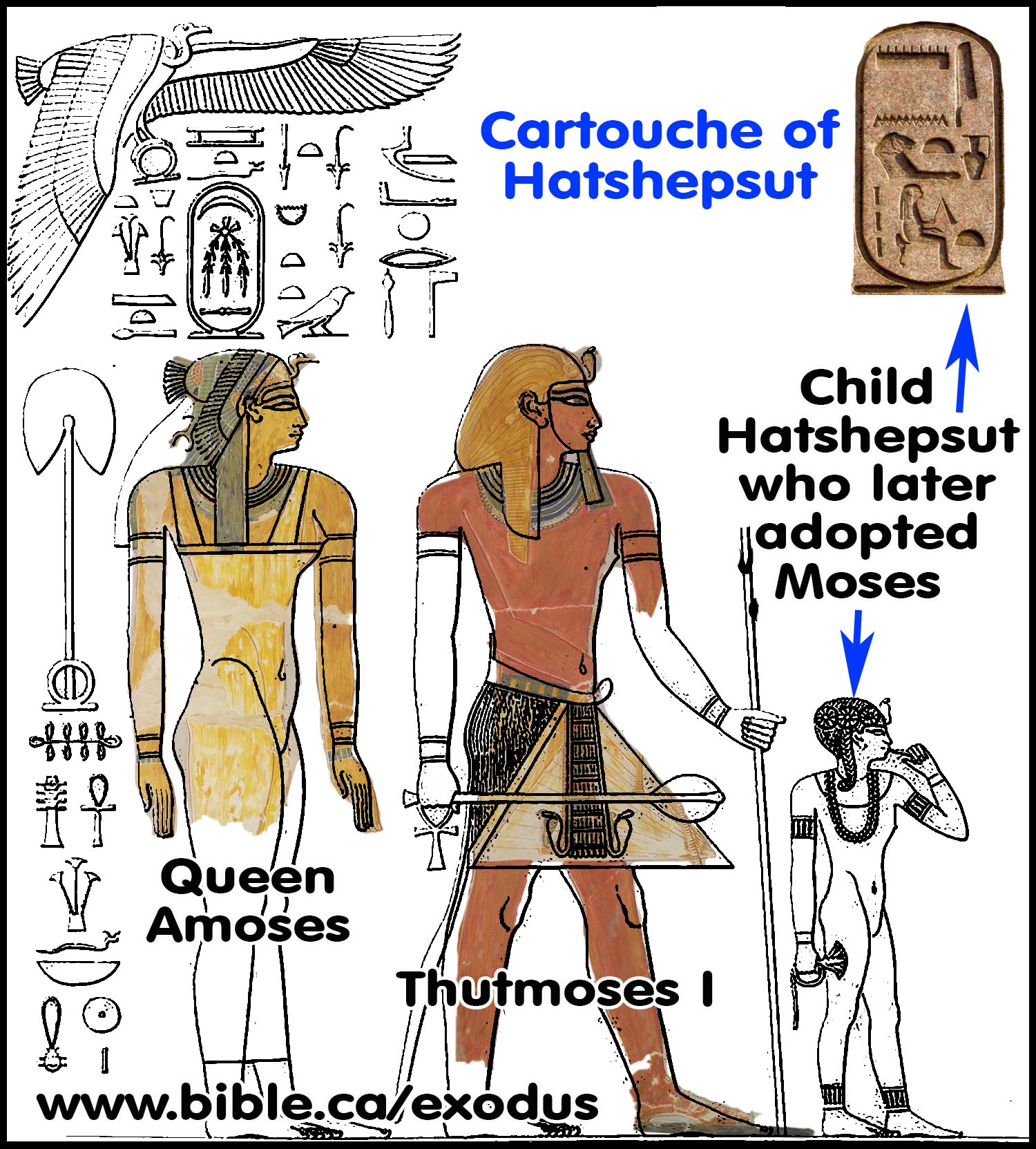
- Hatshepsut, is the only candidate for the "Pharaoh's daughter" who drew Moses out of the Nile.
- Born in 1541 BC, she would have been 15 years old when Moses was born in 1526. Hatshepsut's father was Thutmoses I and her mother was Queen Amoses.
- Queen Ahmose had four children with Thutmosis I, but three died young leaving Hatshepsut as the only person who could wear the title of "Pharaoh's daughter". (Ex 2:7-10; Acts 7:21; Heb 11:24) The bible says that pharaoh's daughter adopted Moses out of pity. However, since she was unable to ever bear a son to Thutmoses II, Moses became her only chance for personal succession. This all changed when Moses was about 30, when Thutmoses II's second wife named Iset, bore him a son named Thutmoses III. Remember that Thutmoses II was Hatshepsut's stepbrother whom she married and jointly raised Moses to adulthood. Moses was heir apparent, until Thutmoses III was born when Moses was 30 in 1496 BC. The timing of the birth of Moses and the much later birth of Thutmoses III is proven by the fact that Thutmoses III was very young while he was coregent with his stepmother Hatshepsut until she died.
- Thutmoses II and Hatshepsut
the pharaohs of oppression:
Thutmoses II and Hatshepsut were married stepchildren. Thutmoses II was the Pharaoh of the oppression who wanted to kill Moses who then fled to Midian. At this time, several things came together all in accordance with God's providence. It all started when Moses killed the Egyptian.
- First: Moses was putting his trust in God and was turning away from the riches of Egypt. (Heb 11)
- Second: a true full blooded "first born heir" to the throne had been recently been born to Thutmoses II through his second wife, Iset.
- Third: this placed enormous pressure on the ambitious Hatshepsut who only had Moses as an adopted "first born" heir.
- Fourth: there was likely a rivalry with bad feelings between Iset and Hatshepsut just like Sarah and Hagar.
- Fifth: Moses, like Hatshepsut, could also "read between the lines" and see that there was an upcoming power battle over the rightful heir to the throne of Egypt between him and Thutmoses III. Queen Hatshepsut was furious woman scorned because "Moses refuses to be called Hatshepsut's son" Heb 11:24. Moses insulted and hurt his stepmother by turning his back on everything she thought was important. In reality, both Thutmoses II and Hatshepsut were out to kill Moses for different reasons and were both "Pharaoh's of the oppression". Thutmoses II wanted to kill Moses to make his biological first-born son, Thutmoses III Pharaoh, because Moses had legal first right! Hatshepsut wanted to kill Moses out of vengeful hurt of rejection as a “mother spurned”.
D. Thutmoses III was the Exodus Pharaoh:
- Moses derives his name from the 18th dynasty not the 19th dynasty of Ramesses.
- "Moses" derives his name from Ahmoses, Thutmoses I and the "Thutmoses" dynasty of kings. Thutmoses I was the father of Hatshepsut who named Moses. It is obvious Moses did not get his name from not from the 19th dynasty era of Rameses II.
- It is sad that bible trashing archeologists deliberately
spell "Thutmoses" in
ways that breaks any connection with "Moses" of the Bible.
These variant spellings include: Tuthmosis,
Tuthmose, Thotmes. Remember that the name "Thutmoses" was written in hieroglyphics
(pictures), but the name Moses is written in Hebrew and Greek. Because we
are certain of how Moses' name was spelled in English, and that he got
his name from Hatshepsut, the daughter of Thutmoses
I, the modern archeological world, and all Bible students would be both
prudent and correct to spell the 18th dynasty pharaohs as "Thutmoses".
This is a case of using the inspired text of the Bible to teach
Egyptologists how to correctly spell the Thutmoses 18th
dynasty of pharaohs!
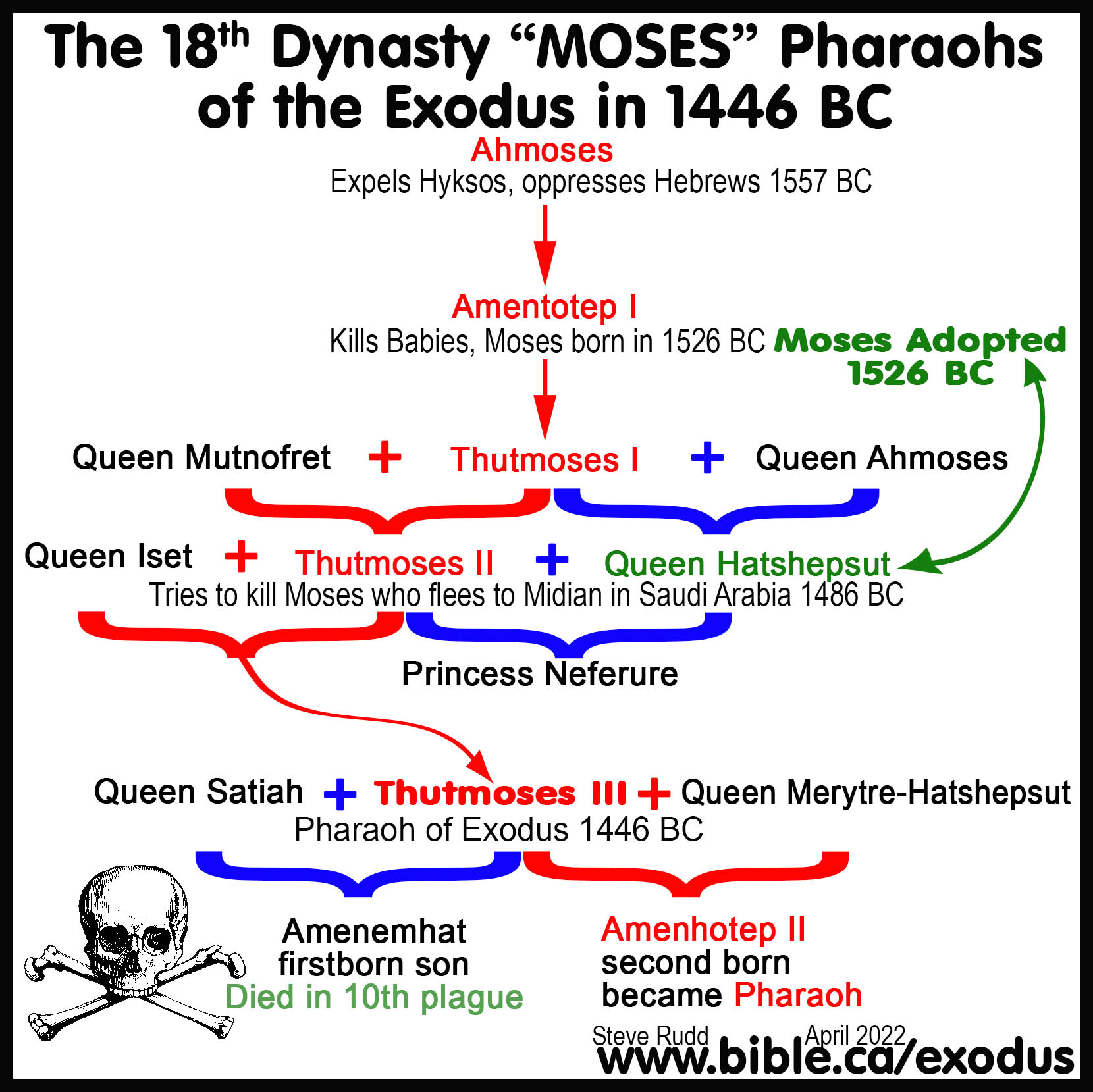
- Thutmoses III was Pharaoh in
1446 BC: (1485-1431, low chronology)
Thutmoses III was Pharaoh in 1446 BC for a total reign of 54 years. (1485-1431). There were three distinct phases to his rule. - First: (1495-1464) from when he was a baby and his step-mother Hatshepsut ruled as co-regent for 21 years. This period is generally ascribed directly to Hatshepsut as Pharaoh, especially since she proclaimed herself pharaoh before she died. Thutmoses III was Hatshepsut step son and when her husband and step brother Thutmoses II died, she ruled until Thutmoses III grew up.
- Second: (1464-1446) after Hatshepsut died Thutmoses III ruled as Pharaoh for 18 years until the exodus.
- Third: (1446-1431) Thutmoses III ruled another 15 years after the exodus.
- Thutmoses III was great, powerful and prideful vs. weak Amenhotep II
- Thutmoses III was one of the greatest and most powerful Pharaohs of Egypt. He is in the class of Herod the Great in 39 BC and Hadrian in 135 AD. Thutmoses III’s son, Amenhotep II, was small, insignificant and unaccomplished in contrast.
- The 17 campaigns of Thutmoses III into the promised land and surrounding areas (Levant), are numbered successively throughout his reign. His 17 campaigns started in the second year and then one campaign each year for the next 17 years, then they ended in 1446! This means that his last campaign ended in year 18 after Hatshepsut died! Thutmoses III’s military conquests softened up Canaan for the eventual conquest of Joshua 40 years later.
- When you are looking for a powerful prideful Pharaoh that God wanted to humble, Thutmoses III is the man.
- This where Thutmoses III’s second born son, Amenhotep II is a poor candidate for the pharaoh of the exodus because he was weak and ineffective! Amenhotep II had only two military campaigns, in contrast to his father’s seventeen.
- Thutmoses III conquered the Mitanni with a powerful surprise attack on his eighth campaign (1436 BC), but Amenhotep II merely signed peace treaties with Mitanni in year 9 of his reign (1422 BC).
|
Victory stele of Thutmoses III The text is a poem praising 'son' for victories over Canaan, Nubia, Mesopotamia, Phoenicia, Cyprus, Asia Minor, Greek Archipelago. Unless this is another case of exaggeration like the Merneptah stele, it appears Thutmoses III had conquered the promised land at the time Israel was at Kadesh Barnea. He was powerful enough, that he may have done such.
|
- The only known Mud brick
making by foreign slaves in 1446 BC:
The only record of mud bricks being made by non-Egyptian foreign slaves is in the tomb of Rekhmire who lived at the same time as Thutmoses III. Pictured below are Hebrews making mud bricks in the Tomb of Rekhmire the Vizier (tomb TT100) in ancient Thebes (Luxor). Dated to Thutmoses III. Although mud brick making was common, it is amazing that the only archeologically known example of non-Egyptian foreign slaves making bricks, dates from the time of the Exodus in 1446 BC.
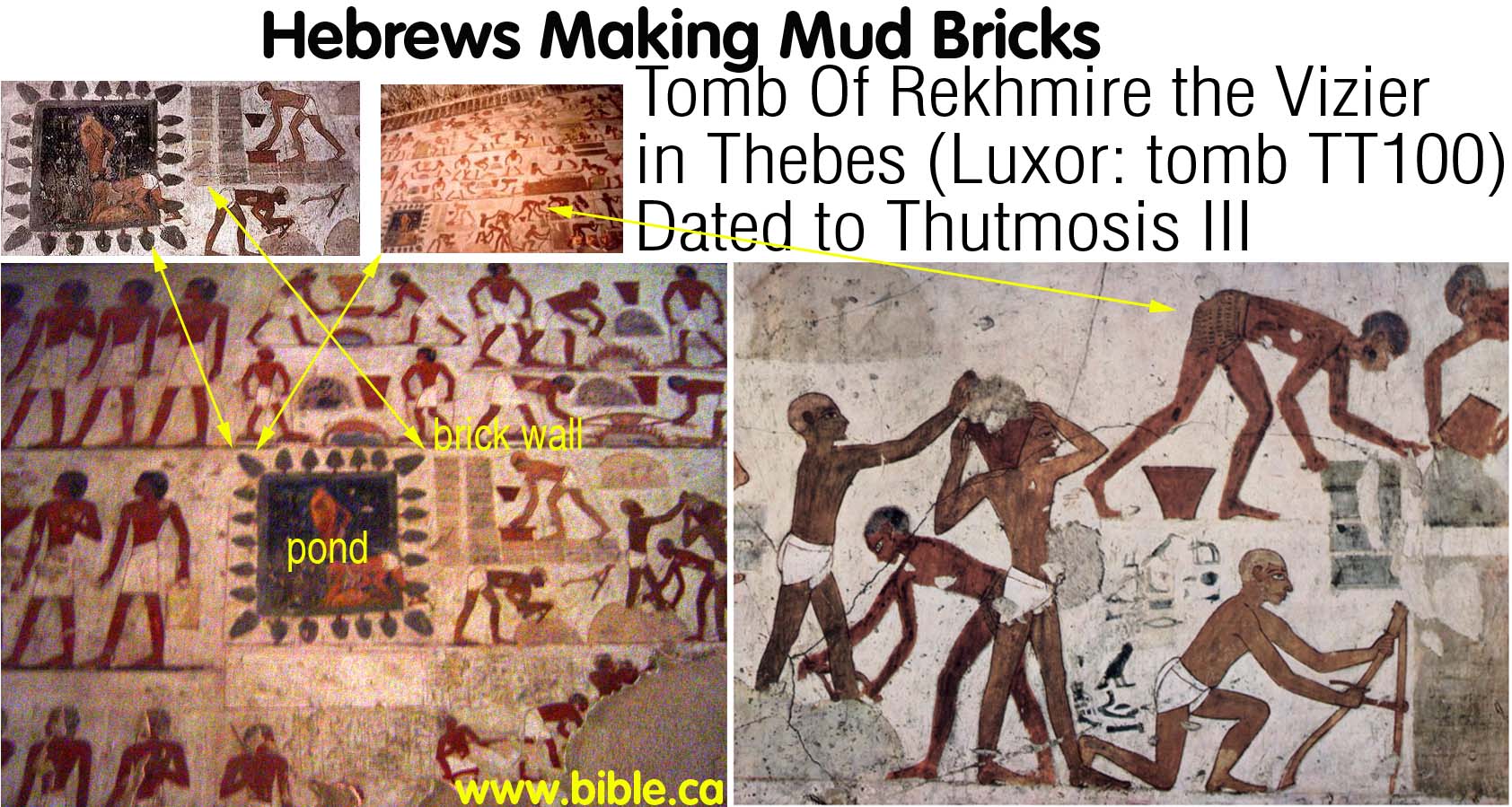
5. Moses was firstborn by adoption and Thutmoses III legally second born:
a. There are two reasons why Thutmoses III survived the tenth plague even though he was biologically first born.
i. First: Even if Thutmoses III was the first born, he was exempted from the 10th plague. God told Moses that after the death of the firstborn, Pharaoh would let Israel Go, not that the 10th plague would kill him. The whole point was to humiliate Pharaoh, not kill him.
ii. Second: Thutmoses III was not the legal "firstborn", merely the biological firstborn.
b. Moses had been adopted into the family and took the legal place of firstborn and therefore heir to the throne. The matter of succession would have become a point of conflict between Hatshepsut and her husband Thutmoses II, once Thutmoses III was born. Thutmoses III would have surely been make fully aware of this huge family fight and it was in his best interest to side with biology.
c. Moses left the matter unresolved when he fled for Midian. The question would have lingered in Thutmoses III's mind until he got his answer in the 10th plague that Moses really was the rightful firstborn heir to the throne he sat upon.
d. When Moses first shows up and demands that his stepbrother "Let Israel go", it was a bizarre irony. Here you have Moses, the rightful legal heir to the very throne that he turned his back on, demanding of Thutmoses III the usurper to let Israel go. The pride and the rivalry must have been enormous for Thutmoses III. After 9 plagues, Moses stands before his stepbrother and says that the first born will die. Thutmoses III had to emphasize his claim as firstborn, in order to gain the throne! Moses' statement that all the firstborn of Egypt would die caused terror to enter Thutmoses III's heart. When Moses said, "you will never see my face again", Pharaoh may have interpreted this to be a prediction of his imminent death.
e. When Thutmoses III survived the death of the firstborn he was relieved to be alive but shamed that he was proven to be a usurper. The fact he did not die, proved that Moses was in fact firstborn and the living rightful pharaoh of Egypt.
- Thutmoses III did not die in the red sea:
a. The Pharaoh of the Exodus did NOT die in the Red Sea. The Bible nowhere says Pharaoh drowned in the Red Sea. Further, drowning in the Red Sea was the easy way out. It was far more humiliating for Thutmoses III to have to travel back to a destroyed Egypt WITHOUT his army to face his people.
b. Some rule out Thutmoses III as a candidate for the Pharaoh of the Exodus BECAUSE he died 15 years after the Red Sea crossing in 1431 BC. It must be noted that using high or low Egyptian chronology neither Thutmoses III or his son Amenhotep II died in 1446 BC in the Red Sea.
c. With all the factual errors in the classic 4-hour Hollywood movie, "THE TEN COMMANDMENTS" with Charlton Heston, the spectacular scene where Pharaoh army are drowned before his eyes and he drops his staff is correct!
d. Ps 136:15 says God "shook off" Pharaoh but didn’t' kill him. The Hebrew word for "overthrew" is literally "shook off" and is metaphoric of ridding the Hebrews of Pharaoh's control. It DOES NOT say that God drowned or killed Pharaoh and his army in the Red Sea.
i. "But He overthrew Pharaoh and his army in the Red Sea" (Psalm 136:15)
e. Notice how scripture carefully differentiates Pharaoh from HIS ARMY:
i. "Then the Egyptians took up the pursuit, and all Pharaoh’s horses, his chariots and his horsemen went in after them into the midst of the sea. At the morning watch, the Lord looked down on the army of the Egyptians through the pillar of fire and cloud and brought the army of the Egyptians into confusion. He caused their chariot wheels to swerve, and He made them drive with difficulty; so the Egyptians said, “Let us flee from Israel, for the Lord is fighting for them against the Egyptians.” Then the Lord said to Moses, “Stretch out your hand over the sea so that the waters may come back over the Egyptians, over their chariots and their horsemen.” So Moses stretched out his hand over the sea, and the sea returned to its normal state at daybreak, while the Egyptians were fleeing right into it; then the Lord overthrew the Egyptians in the midst of the sea. The waters returned and covered the chariots and the horsemen, even Pharaoh’s entire army that had gone into the sea after them; not even one of them remained." (Exodus 14:23-28)
ii. In the victory song of Moses notice it never says Pharaoh himself drowned: "Pharaoh’s chariots and his army He has cast into the sea; And the choicest of his officers are drowned in the Red Sea." (Exodus 15:4)
7. Thutmoses III's annual campaigns ended in 1446:
a. Thutmoses III made 17 yearly military conquests into Canaan and the levant that started in his second year and continued every year until his 18th year which was 1446 BC when his army drowned in the Red Sea.
b. His campaigns did not start until after his coregent stepmother Hatshepsut died in 1464. In the 34 years that Thutmoses III ruled after Hatshepsut died, he launched 17 military campaigns into Canaan and Syria, and Nubia (southern Nile).
c. Thutmoses III’s annual campaigns ended because his army lay 1381 meters (4530 feet, almost a mile) under water at the Straits of Tiran.
d. After 17 annual campaigns, the 18th campaign of 1446 never happened! Nothing in the Bible says that Thutmoses III died with his army in the Red Sea.
8. Defacing and erasure of Hatshepsut by Thutmoses III started
in 1446:
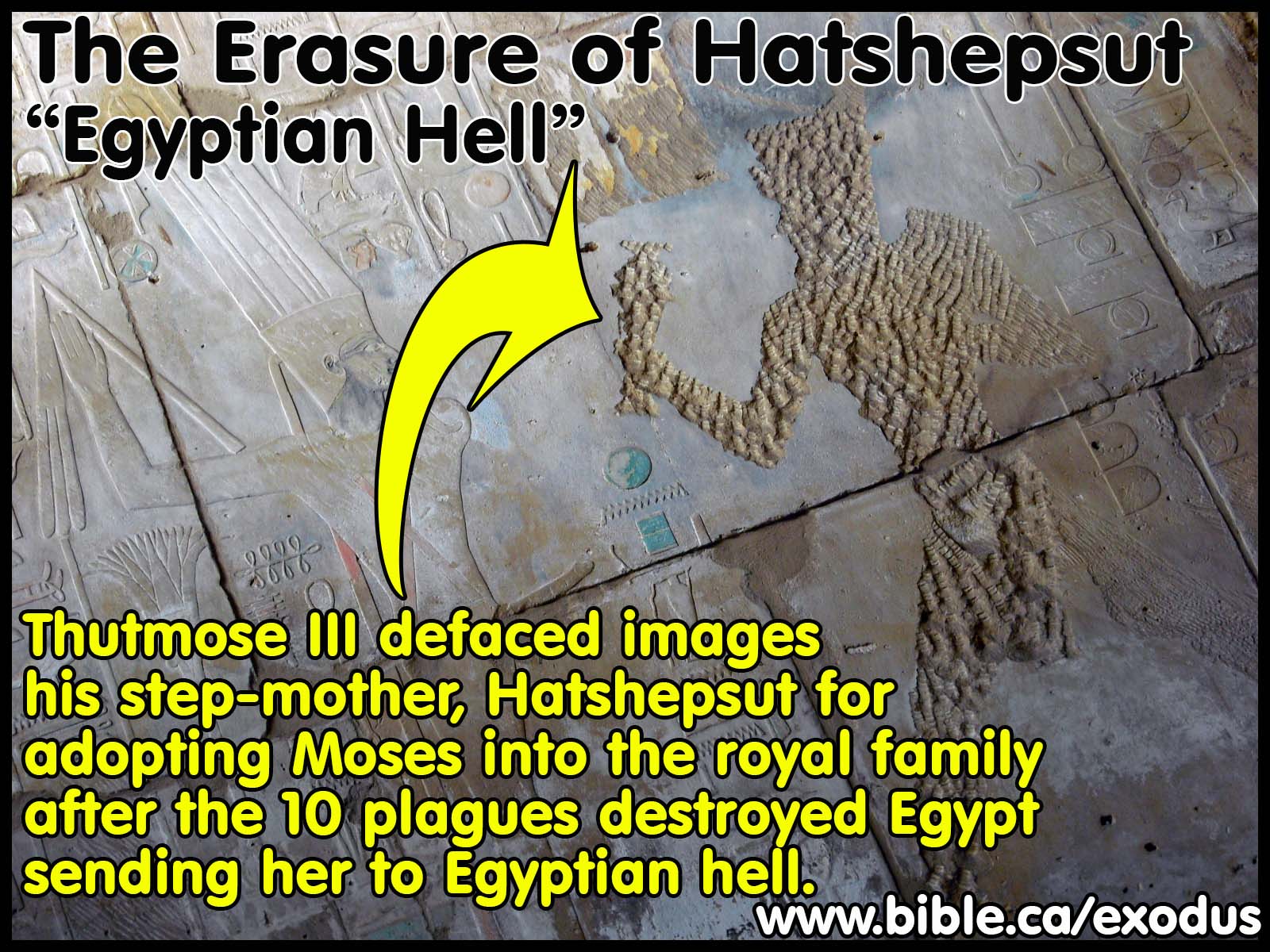
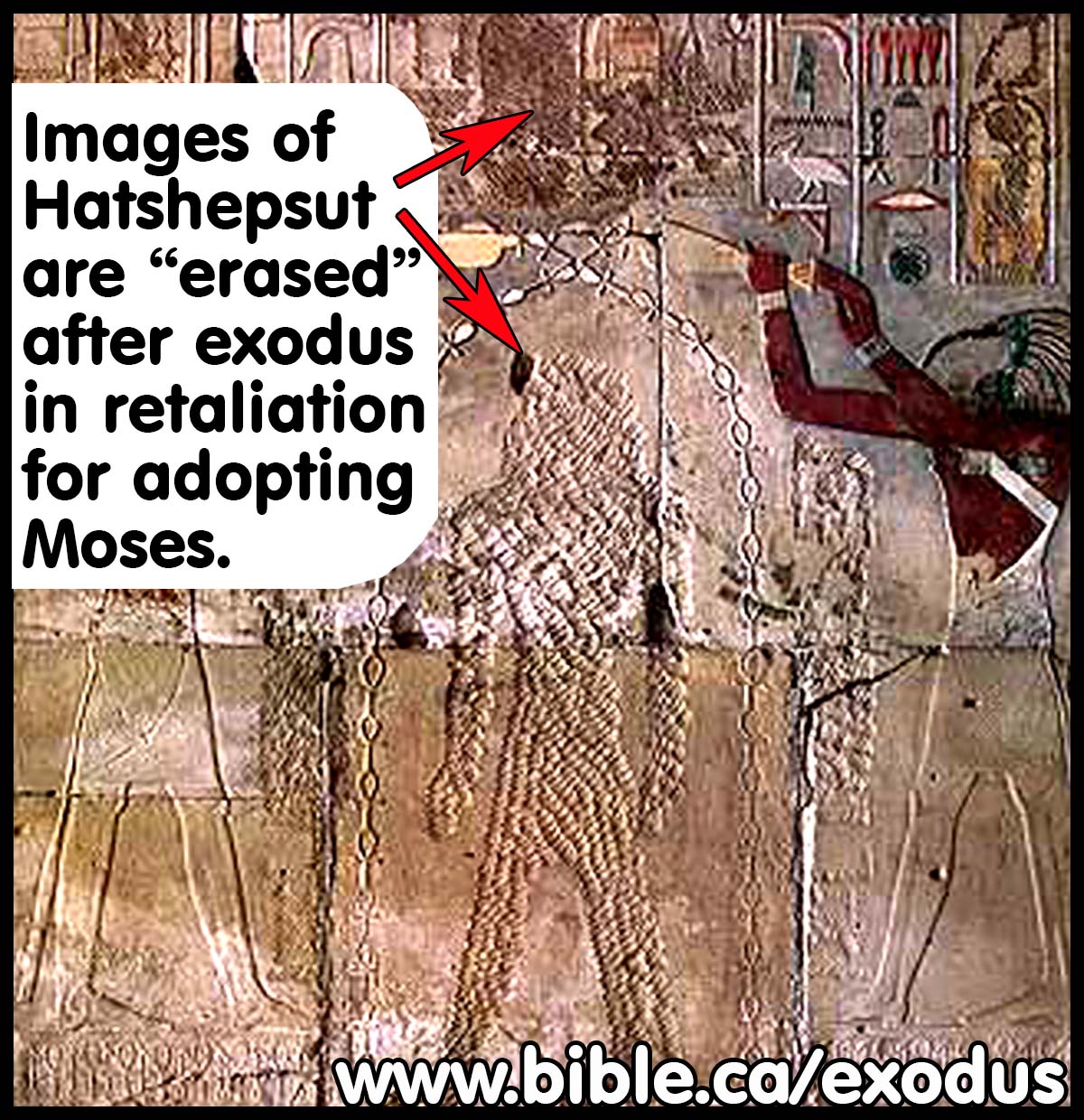
a. Immediately after the Exodus, Thutmoses III erased all evidence of both the Hebrews in Goshen and his step-mother, Hatshepsut for adopting Moses into the royal family.
b. The well documented erasure of Hatshepsut from records and monuments began after 1446 BC at the hand of Thutmoses III.
c. The erasure of Hatshepsut from history did not occur before his 42nd regnal year (year 20 after Hatshepsut died) which brings us to exactly 1443 BC, which is three years after the exodus! Another perfect fit!
d. Bible trashers say Thutmoses III was a misogynist who hated women:
i. Bible trashing historians dismiss the exodus as myth and make it their primary goal is to hide any connection between Egypt and the Exodus. These Bible hating archeologists suggest that Thutmoses III was motivated by sexist male revenge against an "overbearing and dominant wicked feminist step-mother who usurped her female place in a male dominated world"! But this is a ridiculous and strained explanation given the fact that Thutmoses III waited 21 years after the death of Hatshepsut to erase her memory. The anger and revenge of Esau to kill Jacob for stealing the title of first born, had fully subsided after 21 years. (An amazing co-incidence in both numbers and the usurping of the firstborn birthright.)
ii. "If Thutmoses III was the culprit [of erasure], he must have had sufficient motive to attempt to prevent her from living eternally. According to Egyptian religion, removing the name or image of a deceased person was a direct assault on his/her spirit. For him to live forever in the Field of Reeds, his body, image, or name must survive on earth. If all memory of him were lost or destroyed, the spirit too would perish, initiating the much-dreaded "second death," a total obliteration from which there could be no return. This act against Hatshepsut was an attempt to 'condemn her to oblivion - a fate worse than death for an Egyptian.' Thus the extermination of Hatshepsut's image from the earth was indeed a drastic step: the removal of her spirit from its perpetual existence in the afterlife. Such reprisal seems far too severe to fit the motive of mere sexism." (Amenhotep II and the Historicity of the Exodus Pharaoh, Douglas Petrovich).
9. Defacing and erasure of Senenmut (or Senmut) by Thutmoses III in 1446:
|
Senmut was a man: Senmut literally means, "mother's brother" which fits well with an older trusted servant. The statue (right) in the Louvre museum shows Senmut as a male. You can see his nipple. Important women in Egypt, like women today, wear tops! So that settles it. There are no bearded statues of a topless Hatshepsut with nipples showing. These show her bearded but fully clothed with obvious breasts under her shirt. The inscription on the stone says: "Neferure: daughter of Pharaoh." |
a. Thutmoses III not only ordered the erasure of all images of Hatshepsut, but also to a man known in history as "Senenmut".
b. Senmut was one of Hatshepsut's most trusted advisers. Perhaps he was seen by Thutmoses III, as being a contributor to the exodus disaster that came upon Egypt.
c. Thutmoses III was a baby when his father died and he inherited the throne, since Moses had very recently fled to Midian. This explains why Hatshepsut ruled as co-regent with her stepson, Thutmoses III for 21 years until her death.
d. The Cairo museum has a statue of "Senmut" with a baby's head in front. (below left) Senmut was an elderly man whom Hatshepsut trusted. He is often pictured with Neferure (daughter of Pharaoh) as a child. This is the correct interpretation. Being an old man, it may be that Senmut was Hatshepsut's nurse, as well as Thutmoses III's and Neferure's (Hatshepsut daughter).
e.
Wild Speculation and Fiction:
Myth #1: In the statues, the adult is Hatshepsut
and the child is Moses.
Myth #2: Neferure = Hatshepsut = Nefure.
Myth #3: Hatshepsut did not have a daughter
named Neferure. Neferure is Hatshepsut.
Myth #4: Senmut = Moses = Hatshepsut Xnem Amen =
Thutmoses II.
Myth #5: The statues memorializes baby Moses
under the care of the daughter of Pharaoh.
Myth #6: Moses actually became Pharaoh with the
title Thutmoses II.
f. Facts: In the statues, the adult is Senmut and the child is Neferure. Neferure was the daughter of Hatshepsut. The name Nefure is never applied to Hatshepsut but is a fictional invention. Hatshepsut married Thutmoses II not Moses. However, because it is a fact that Hatshepsut wore a fake beard and took on the male persona later in her reign, some mistakenly believe the adult in the statue is her, not the male servant Senmut (or Senenmut). These two statues are not of a "fake bearded Hatshepsut" (aka Neferure) and the baby is Senmut, which is another name for Moses.
g. Senmut remained single his whole life, (probably because he was a eunuch), disappeared mysteriously and his tomb was unfinished. This fueled the speculation that Senmut is Moses who also unmarried before he fled Egypt for Midian at age 40.
h. The adult in these two statues is Senmut, a trusted steward of Queen Hatshepsut, and Thutmoses III defaced his statues because of Senenmut's obvious close role he played in association with Hatshepsut. Senmut is not Moses, Neferure is not Hatshepsut. However, it is entirely possible that Senmut, being Hatshepsut's "mother’s brother", was the official "eunuch guardian" that cared for Hatshepsut as a baby and later Moses, Thutmoses III and Neferure!
i. Thutmoses III defaced both Hatshepsut and Senmut statues and wanted to erase them both from history as a direct result of the exodus in 1446 BC.
E. Amenhotep II: Second born son who survived the 10th plague (1431-1406 BC)
1. Amenhotep II was "second born" son of Thutmoses III:
a. Thutmoses III is confirmed as the pharaoh of the exodus in that his firstborn son "Amenemhat" by Queen Merytre-Hatshepsut died in the 10th plague but his second born son, Amenhotep II survived the 10th plague and succeeded Thutmoses III on the throne.
i. Thutmoses III’s firstborn son Amenemhat by was killed by the tenth plague.
ii. In the providence of God, it is well documented that Amenhotep II, was Thutmoses III's second born son by Queen Satiah, who became Pharaoh in 1431 BC.
b. Low vs. high Egyptian chronology:
i. Using low Egyptian chronology, Amenhotep II survived the 10th plague in 1446 BC, then died exactly 40 years later when Joshua crossed the Jordan in 1406 BC! He survived death the year the slaves left Egypt and died the year the runaway slaves became a nation with land of their own!
ii. Using high Egyptian chronology, those who wrongly believe Amenhotep II was the pharaoh of the exodus, have no evidence that his firstborn son died in the 10th plague of 1446 BC. In other words, we are 100% sure that Amenhotep II was not firstborn and 0% sure that Amenhotep II’s own firstborn son died before he did.
2. Amenhotep II: Replacement Slaves in 9th year conquest of 1422 BC
a. While Amenhotep II makes a poor choice as the pharaoh of the exodus, he had one successful campaign into Canaan year 9, 1422 BC, when Israel was at Kadesh Barnea year 22. Amenhotep II had to go on a raid to replenish 3 million lost Hebrew slaves 22 years earlier because of the exodus. Amenhotep II records his capture of 101,128 slaves in Canaan during his 9th year campaign in 1422 BC. In truth, the year 9 campaign was more about refueling a devastated nation, rather than a truly powerful display of military might like that of his father, Thutmoses III.
b. The Memphis Stela documents Amenhotep II's two campaigns. The first into Syria in year 7 (May 15, 1424 BC), and the second into Canaan and Edom in Year 9 (Nov 15, 1422 BC). However, the Amada Stela and Elephantine Stela both indicate the first campaign happened in year 3 (July 4, 1428 BC). In year 9 (1422 BC), Amenhotep II signed a peace treaty with the king of Mitanni. Strangely, the total number of slaves captured in the stela is 89,600, but the sum of the individual numbers add up to 101,128 slaves.
i. "A record of the plunder that his majesty carried off: 127 princes of Retenu; 179 brothers of princes; 3,600 Apiru [or Habiru Hebrews at Kadesh Barnea]; 15,200 Shasu; 36,300 Kharu; 15,070 Nagasuites/Neges; 30,652 of their family members; total: 89,600 people, and their endless property likewise; all their cattle and endless herds; 60 chariots of silver and gold; 1,032 painted chariots of wood; 13,500 weapons for warfare." (Amenhotep II, Memphis Stela, 2nd campaign, year 9, 1422 BC)
c. The capture of 3600 Habiru (Hebrews) in 1422 BC occurred year 24 of the exodus and year 22 at Kadesh Barnea. The 3600 men were likely deserters from Kadesh Barnea who had complained to Moses. The Bible records more than once, that Israel mutinied Moses and started marching back to Egypt. Evidently 3600 of these Hebrews got their wish and were once again enslaved in Egypt by Amenhotep II. Good riddance!
i. "We remember the fish which we used to eat free in Egypt, the cucumbers and the melons and the leeks and the onions and the garlic, but now our appetite is gone. There is nothing at all to look at except this manna." Numbers 11:5-6.
ii. "So they said to one another, "Let us appoint a leader and return to Egypt.” (Numbers 14:4)
F. Amarna Tables document the conquest of Joshua in 1406 BC
|
The Amarna Tablets (1404 - 1341 BC) More: Amarna Tablets which chronicle the conquest of Joshua Tablet EA 286: "The Habiru are now capturing the fortresses of the Pharaoh. Not a single governor remains among them to my lord the King: all have perished. Zimrida of Lachish has been killed. May the King send help. Lo, if no reinforcements come this year, all the countries of my lord the King will be utterly destroyed. ... The land of the King is lost to the Habiru. And now indeed a city of the territory of Jerusalem, Bet-Ninib, has been captured. ... After taking the city of Rubuda, they are now attempting to take Jerusalem... , What have I done against my lord the King, that thou lovest the Habiru, and hatest the governors? ... The Habiru have wasted all the territory of the King', and so on." (Amarna Tablet, A Letter from Abdu-Heba of Jerusalem, EA 286) Tablet EA 276: "They are now attempting to take Jerusalem. ... Gezer, Ashkelon, and Lachish have given oil, food, and supplies to the Habiru. ... Labaya and the land of Shechem have given all to the Habiru." (Amarna Tablet, A Letter from Abdu-Heba of Jerusalem, EA 287) |
1. The 382 Amarna Letters represent one of the greatest archeological proofs that the conquest under Joshua of the promised land is true.
a. The Amarna Letters fully document the Habiru (Hebrews) conquest of Canaan by Joshua starting in 1406 BC.
- The Amarna tablets are a second record of the conquest from Egyptian and Canaanite cuneiform tablets written in Akkadian Babylonian.
c. A broader date for the Amarna tablets is 1404 - 1340 BC (64 years). They cannot be any earlier than the beginning of the conquest of the Judah (1404 BC) or any later when Amarna was destroyed in the second year of King Tut (1340 BC). These dates represent the outer limits and the actual period of the Amarna letters is likely shorter than 64 years.
2. David Rohl destroys this powerful synchronism with the conquest by shifting the date for the Amarna tablets and Akhenaten to the time of king Saul of Judah.
a. During the time of Saul and David the promised land was under the control of the Philistines not Egypt.
b. In the Bible narrative of Saul, David and Solomon, Egypt is never even mentioned at a combatant.
c. In Rohl’s chronology, the mass Philistines immigration into Canaan did not occur until the 8th year of Ramesses III which he misdates to 916 BC.
d. Rohl believes Ramesses II is the same person as Shishak of the Bible (945-924 BC) who attacked Jerusalem in 925 BC and died in 924 BC.
e. This means that the Philistines did not mass migrate into Canaan until 916 BC (8th year of Ramesses III).
f. Rohl therefore cannot use the Amarna tablets to document the conquest of Joshua. Rohl has Saul fighting the Egyptian control of Canaan as seen in the Amarna Tablets but Egypt is not mentioned in the Bible even once during the reign of Saul or David in any way. The Bible shows Saul’s main enemy was the Philistines where David killed Goliath, yet according to Rohl, this was 100 years before the Philistines arrived in large numbers after the death of Solomon in 924 BC.
3. The Hebrew conquest of Canaan under the command of Joshua took exactly eight years to complete (1407-1399 BC) but it wasn't until 1404 BC that Joshua began the conquest of southern Israel, followed by the conquest of northern Israel.
a. Aaron died on the 1st day of the 5th month of the 40th year of the wilderness wandering (summer 1407 BC). Shortly after mourning Aaron for 30 days, the people left Mount Hor, defeated the Transjordan nations, and then mourned for Moses 30 days. They crossed the Jordan on the 10th day of the 1st month of the 41st year (spring, 1406 BC), four days before the 41st Passover, which was exactly 40 years to the day they left Goshen. They started counting sabbatical years and Jubilee after crossing the Jordan. (Num 33:38; 20:28; Deut 34:8; Josh 4:19; 5:10)
b. From Josh 14:10 we know that Caleb was given Hebron 45 years after Moses promised it to him. This corresponded with year 5 after crossing the Jordan in 1406 BC. Caleb possessed Hebron in 1401 BC.
c. “Now behold, the Lord has let me live, just as He spoke, these forty-five years, from the time that the Lord spoke this word to Moses, when Israel walked in the wilderness; and now behold, I am eighty-five years old today." (Joshua 14:10)
4. A cry for Egypt to send military help:
a. The letters are correspondence between the city kings of Canaan to pharaoh in Egypt where they beg pharaoh to send troops to defend against the invading Hebrews. There is no evidence that Egypt ever sent any troops as requested but remained a distant observer as Joshua conquered Canaan.
b. Collectively, the Amarna tablets tell the story of how the local Canaanite population first begged Egypt for help, then betrayed and deceived each other for survival and committed treason by surrendering to the Hebrews.
c. Most of the local Canaanites were killed by the invading “Habiru”.
5. In a breathtaking confirmation of the conquest of Joshua the cities of Jerusalem, Shechem, Gezer, Ashkelon, Lachish and others are mentioned by name in the Amarna Tablets.
6. One tablet exactly agrees with the Bible in that Shechem was taken early "given all to the Habiru" and other tablets confirm that the unconquered cities of Jerusalem, Gezer, Ascalon, and Lachish had started to pay tribute: "given oil, food, and supplies to the Habiru".
a. Jerusalem was taken in a later stage after the death of Joshua: " Now it came about after the death of Joshua that the sons of Israel inquired of the Lord, saying, "Who shall go up first for us against the Canaanites, to fight against them? ... Then the sons of Judah fought against Jerusalem and captured it and struck it with the edge of the sword and set the city on fire." Judges 1:1,8
b. Ashkelon was taken in a later stage after the death of Joshua: "And Judah took Gaza with its territory and Ashkelon with its territory and Ekron with its territory." Judges 1:18
c. Gezer was not immediately captured: "But they did not drive out the Canaanites who lived in Gezer, so the Canaanites live in the midst of Ephraim to this day, and they became forced laborers." Joshua 16:10
7. Complete list of conquered cities in the Amarna Tablets:
|
Bible city name |
Amarna city name |
City mayor/king |
|
Acco |
Akka |
Satatna & Surata |
|
Aijalon |
Ayyaluna |
|
|
Ammiya |
|
|
|
Arka |
Irqata |
Aduna |
|
Arvad Island |
Arwada, Ruad |
|
|
Ashkelon |
Ashqeluna |
Yidya |
|
Ashtaroth |
Astartu |
Biridashwa & Ayyab |
|
? |
Batruna |
? |
|
Berothai, Berothah |
Beirut, Biruta, Berytus |
Ammunira |
|
Cypress |
Alashiya |
|
|
Damascus |
Dimaški |
Biryawaza |
|
Gammad |
Kumidu, Gammadim, Gammatites |
|
|
Gaza |
Hazzatu |
Yahtiru |
|
Gebal |
Byblo, Gubla |
Rib-Hadda |
|
Gezer |
Gazru |
Milkilu & Yapahu |
|
Hamath |
Lapana, Ematu |
Teuwatti/Tiwati |
|
Hazor |
Hasura |
Abdi-Tirshi |
|
Hebron |
Qiltu (might be Keilah) |
Shuwardata |
|
Jerusalem |
Jerusalem |
Abdi-heba |
|
Joppa |
Yapu |
|
|
Kadesh on the Orontes |
Qidsu, Qissa, Qinsa |
Etakkama/Aituamma |
|
Keilah |
Qiltu (Might be Hebron) |
Shuwardata |
|
Kenath |
Qana, Nobah |
|
|
Lachish |
Lakisha |
Zimredda & Shipti-bala |
|
Megiddo |
Magidda |
Biridiya |
|
Qatna |
Mishrefeh |
Akizzi |
|
Shechem |
Sakmu |
Labayu |
|
Sidon |
Siduna |
Zimredda |
|
Shiloh |
Silu |
Yaptih-Hadda |
|
Sumur |
Simyra, Zemar |
|
|
Taanach |
Tahnaka |
|
|
Tunip |
Tunip |
Aki-Teššup |
|
Tyre |
Surru |
Abi-Milku |
|
Ugarit |
Ugaritu |
Niqm-Adda II |
|
? |
Muhhazu |
? |
G. The conversion of Akhenaten to monotheism
1. One of the most stunning events in religious history is the conversion of Akhenaten to monotheism in 1358 BC.
2. Akhenaten became Pharaoh in 1358 BC only 2 years before Joshua died in 1356 BC. He reigned 17 years and died in 1341 BC.
a. Akhenaten was very aware of the power of the Hebrew God which demanded monotheistic worship.
b. As Pharaoh, he knew how the 10 plagues of Moses had destroyed Egypt.
c. He would know how the Hebrews had crossed the Red Sea on dry ground through 300-meter-high walls of water on either side, which came crashing down to drown Egypt's entire military.
d. It was clear to Akhenaten the monotheistic God of the Hebrews was superior to the polytheistic pantheon of Egyptian gods.
e. Akhenaten could clearly see that monotheism was superior to polytheism.
f. Akhenaten converted to monotheism by worshipping the sun god, "Aten".
3. Akhenaten's conversion to monotheism (sun worship) is a stunning marker unparalleled in Egyptian history and only the exodus and conquest can explain it.
Conclusion:
- The evidence that Thutmoses III was the Pharaoh of the exodus is overwhelming. The only other possible candidate might be Amenhotep II, his son, but he pales against the towering stature of his father in all ways.
- Pharaoh who killed Hebrew children: Amunhotep I: 1532-1511 BC
- Pharaoh's Daughter who adopted Moses: Hatshepsut: 1526 BC
- Pharaoh of Moses' flight to Midian: Thutmoses II + Hatshepsut: 1498-1485 BC
- Pharaoh of the Exodus: Thutmoses III: 1485/1464 - 1431 BC
- The Bible is quite clear that the exodus happened in 1446 BC.
By Steve Rudd: Contact the author for comments, input or corrections.
